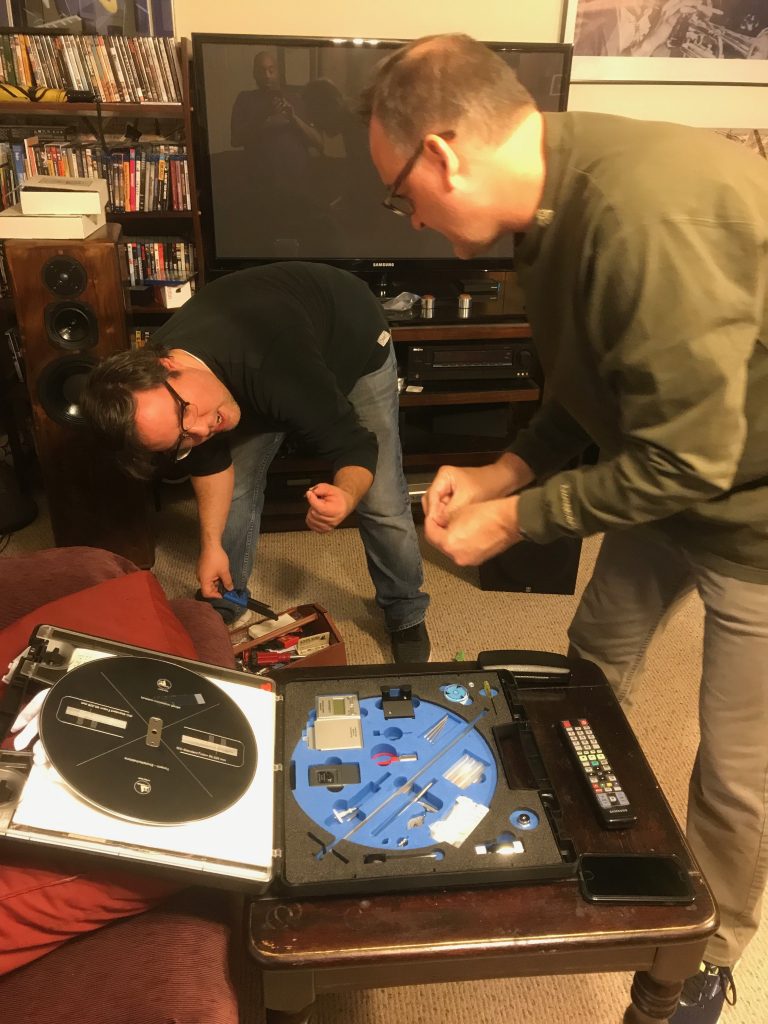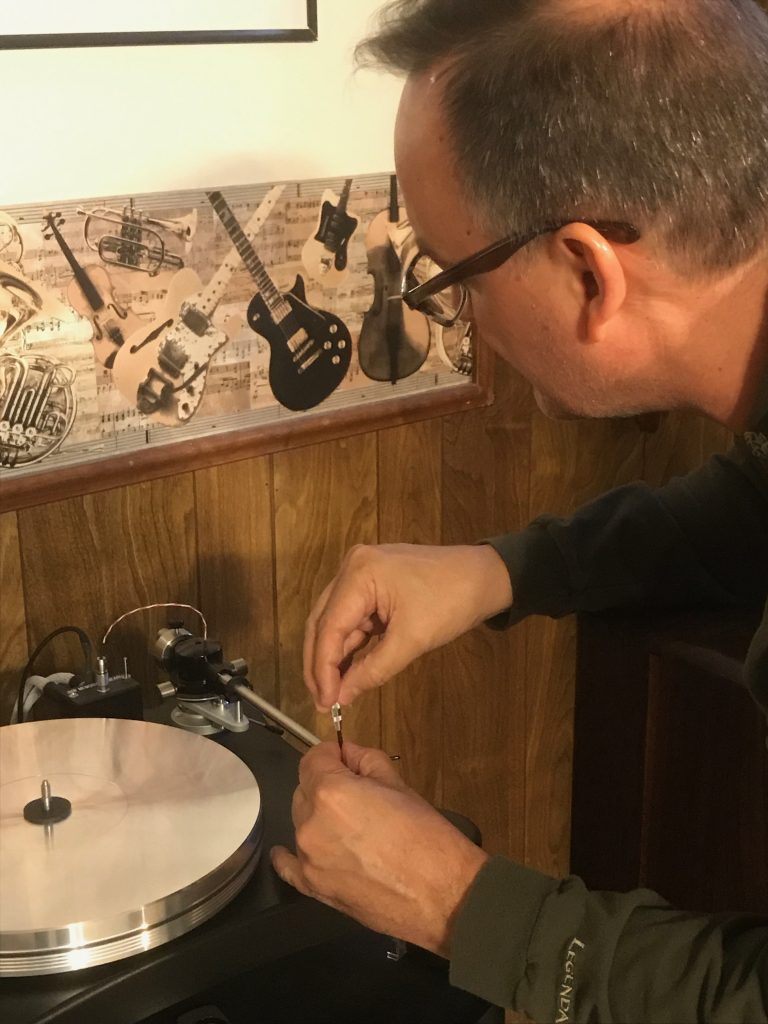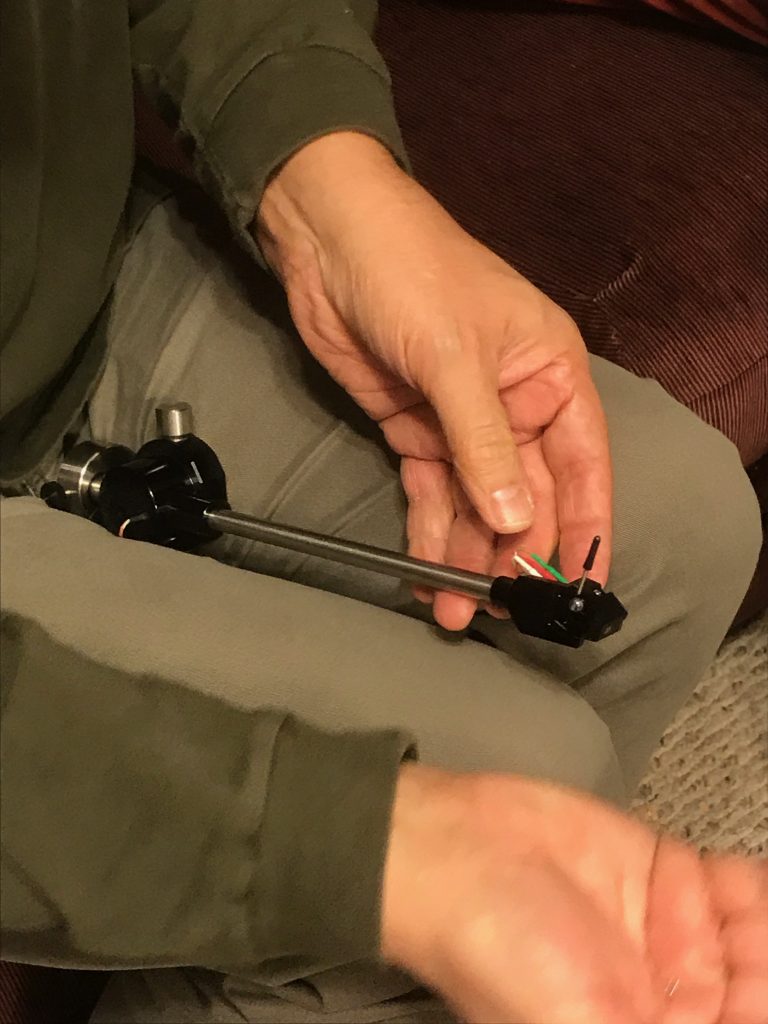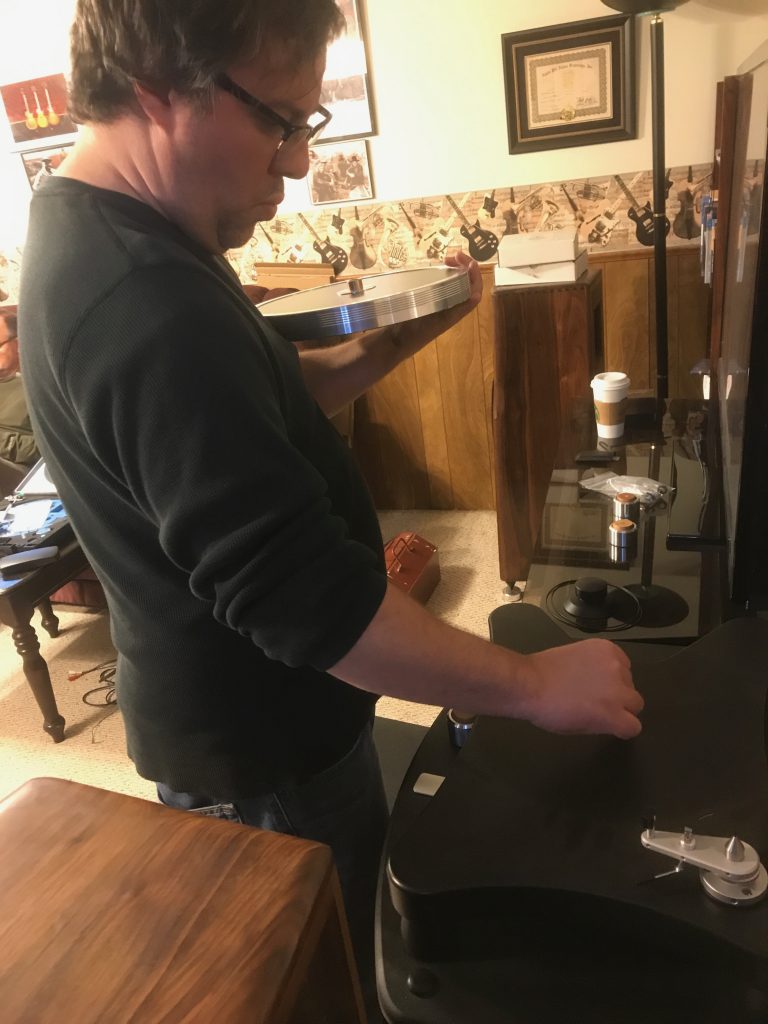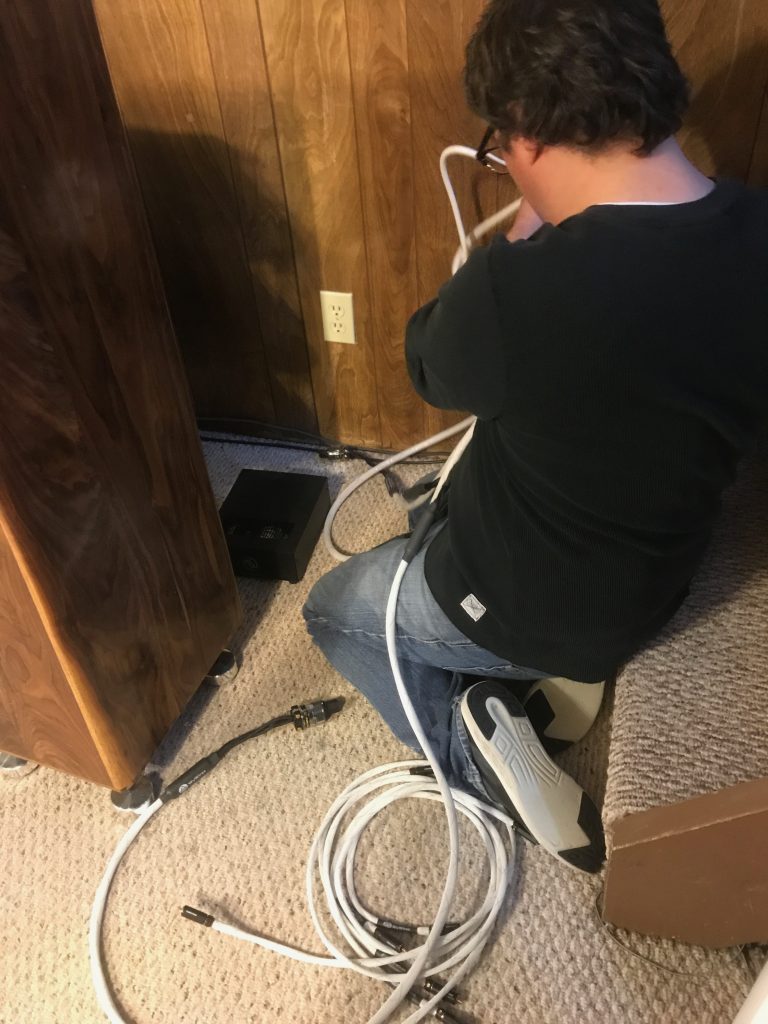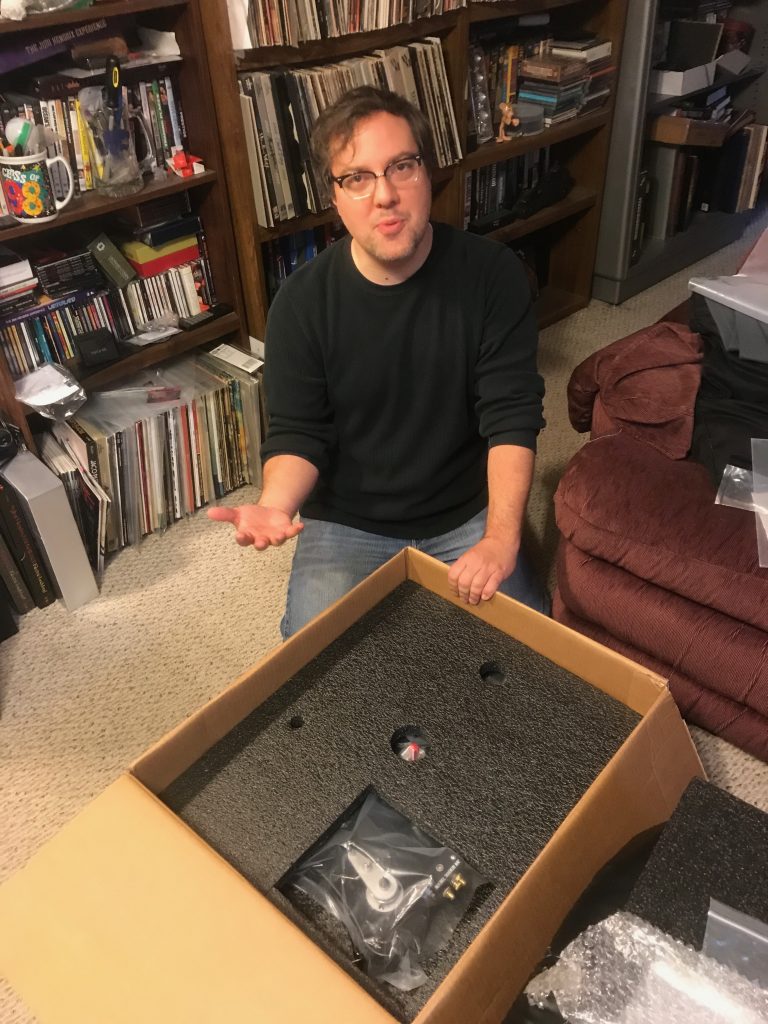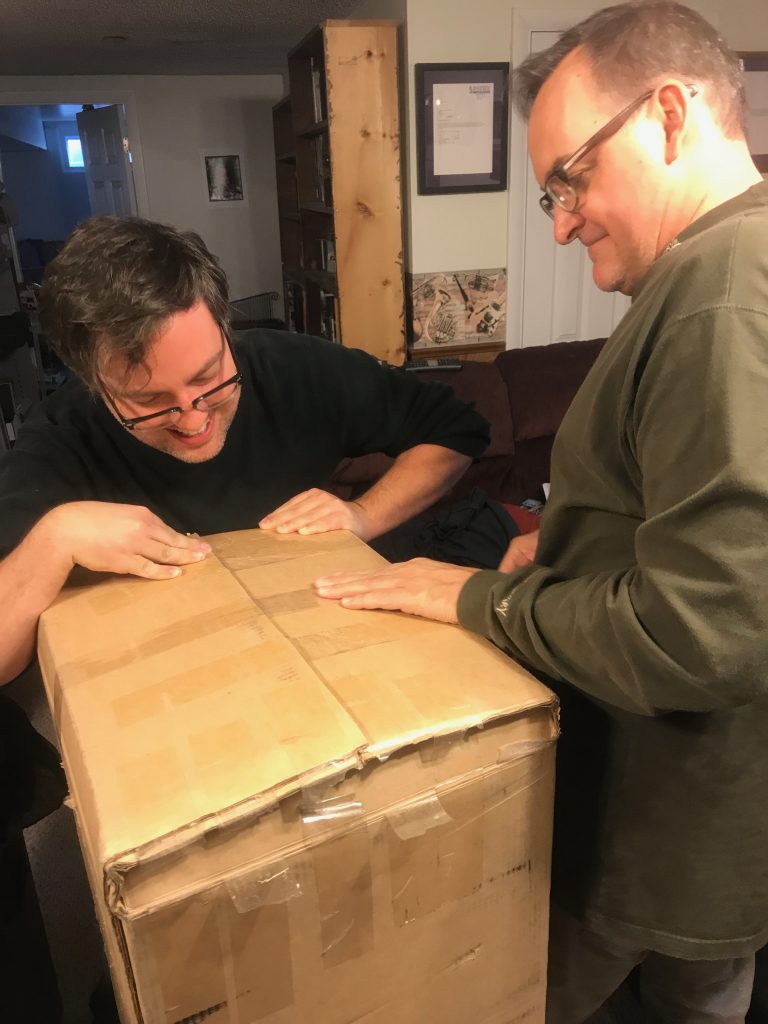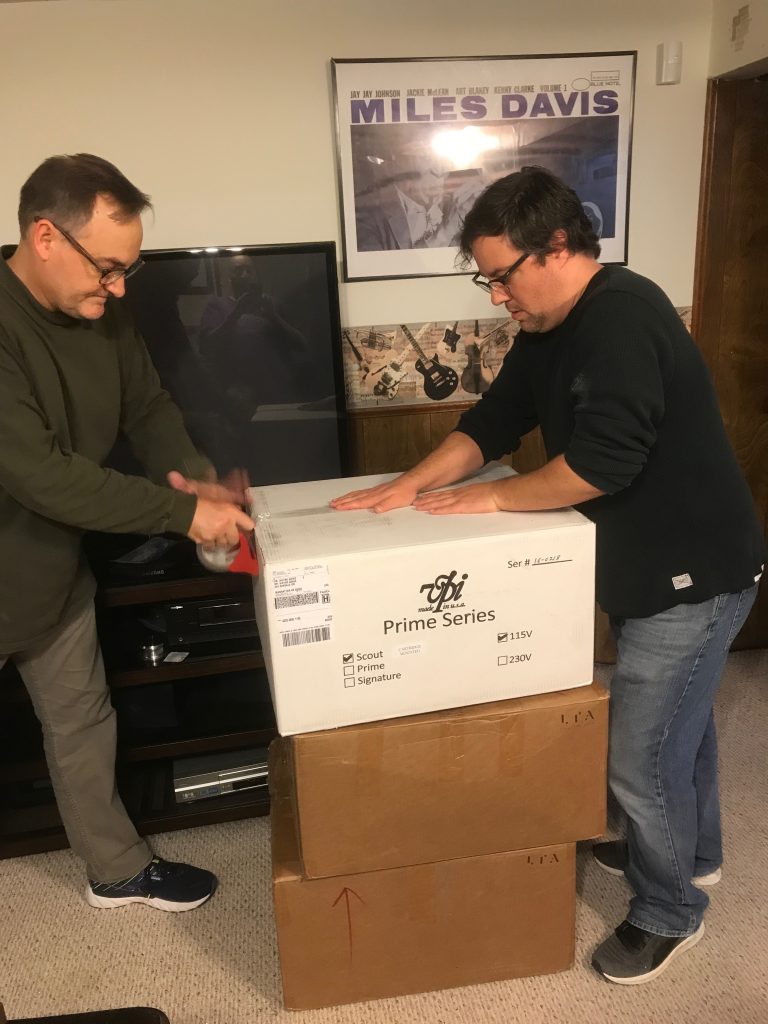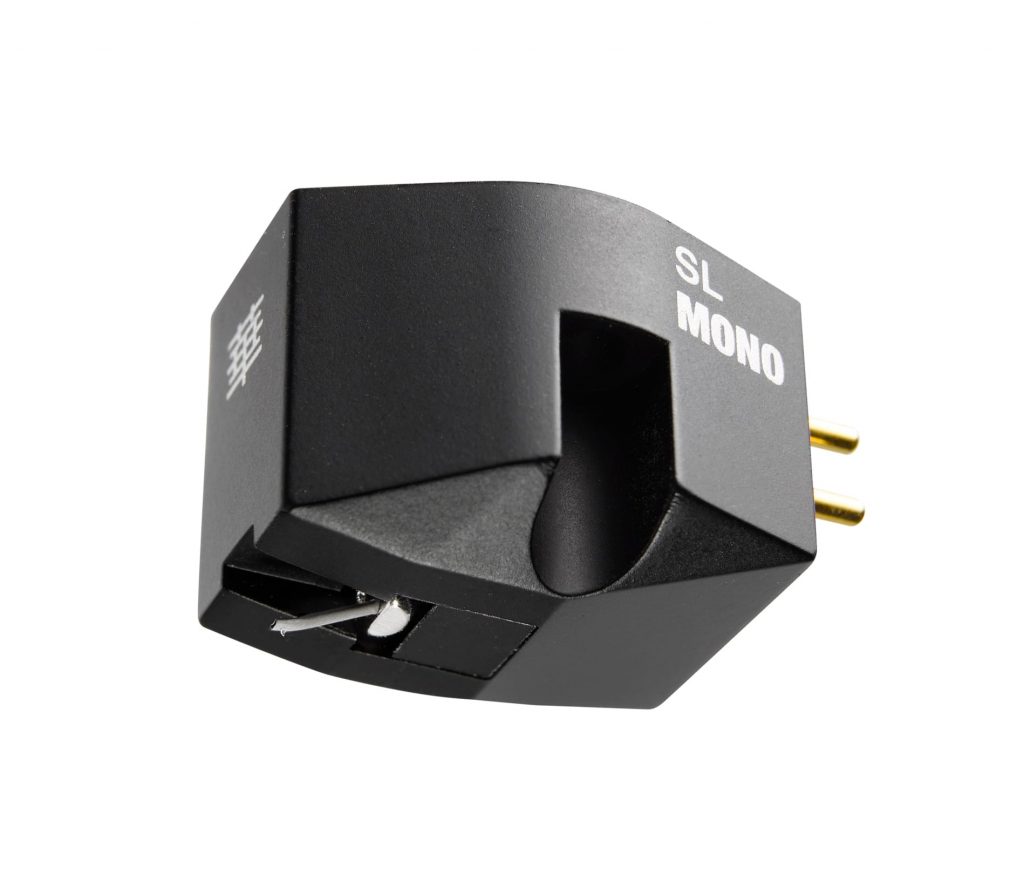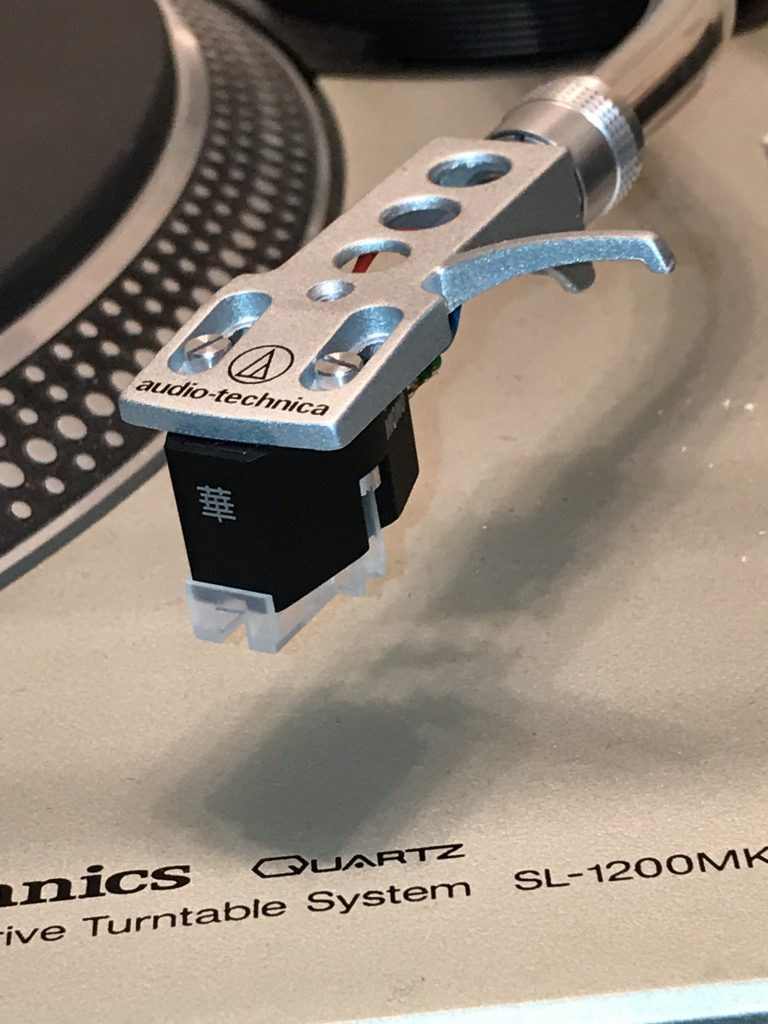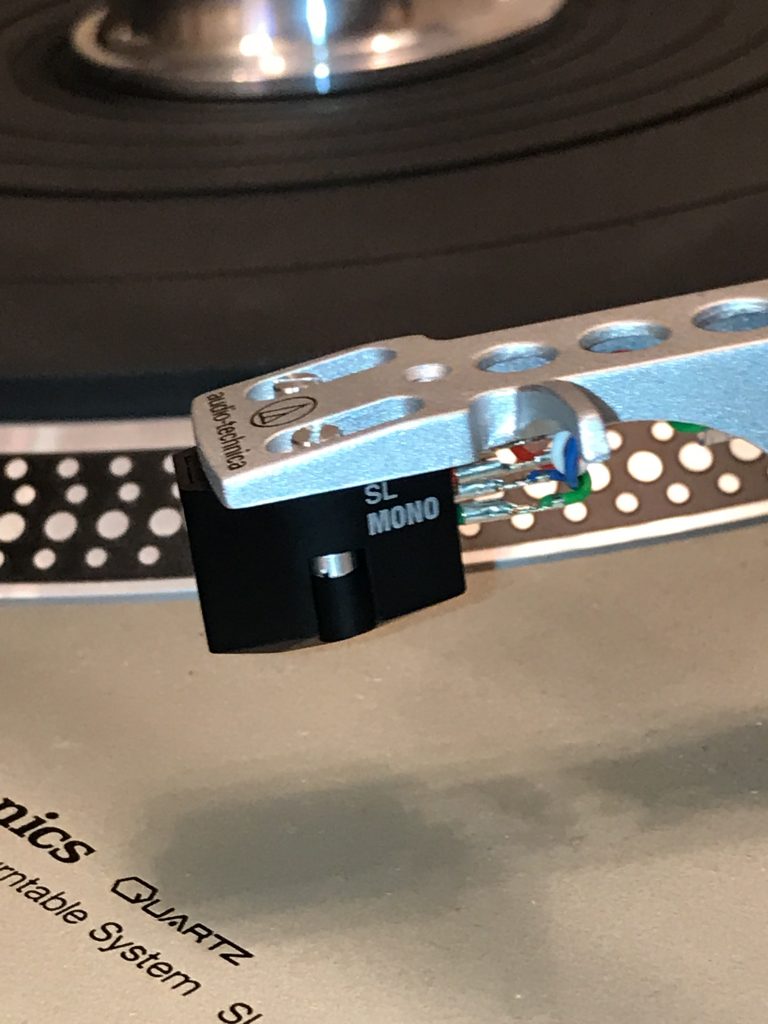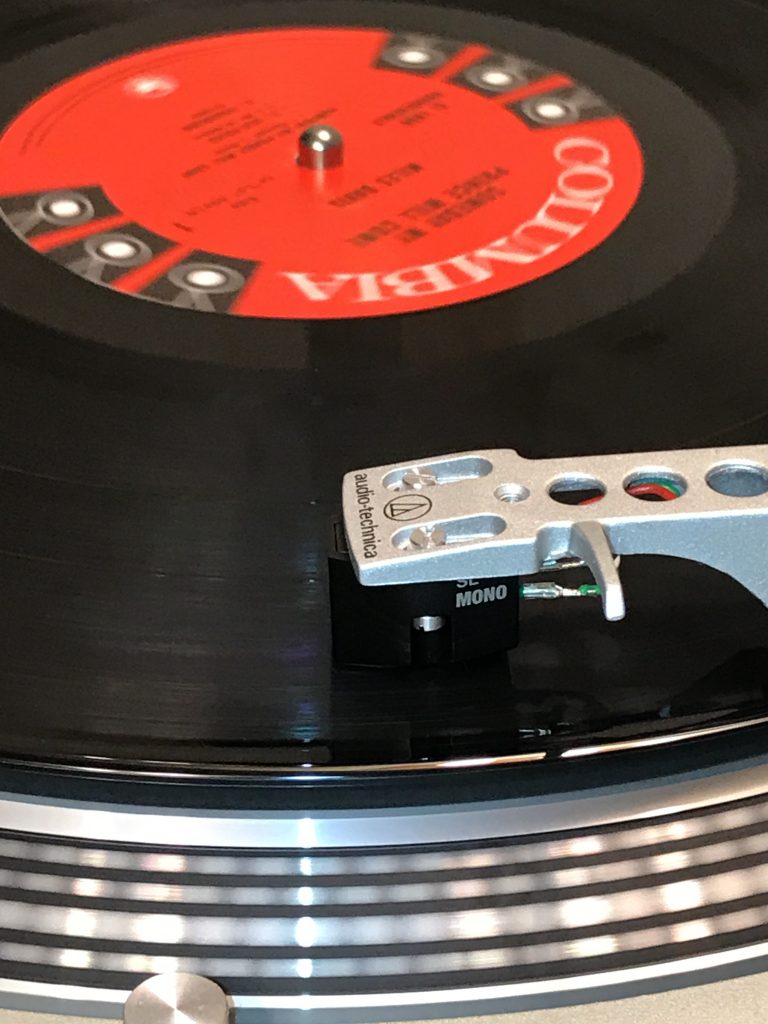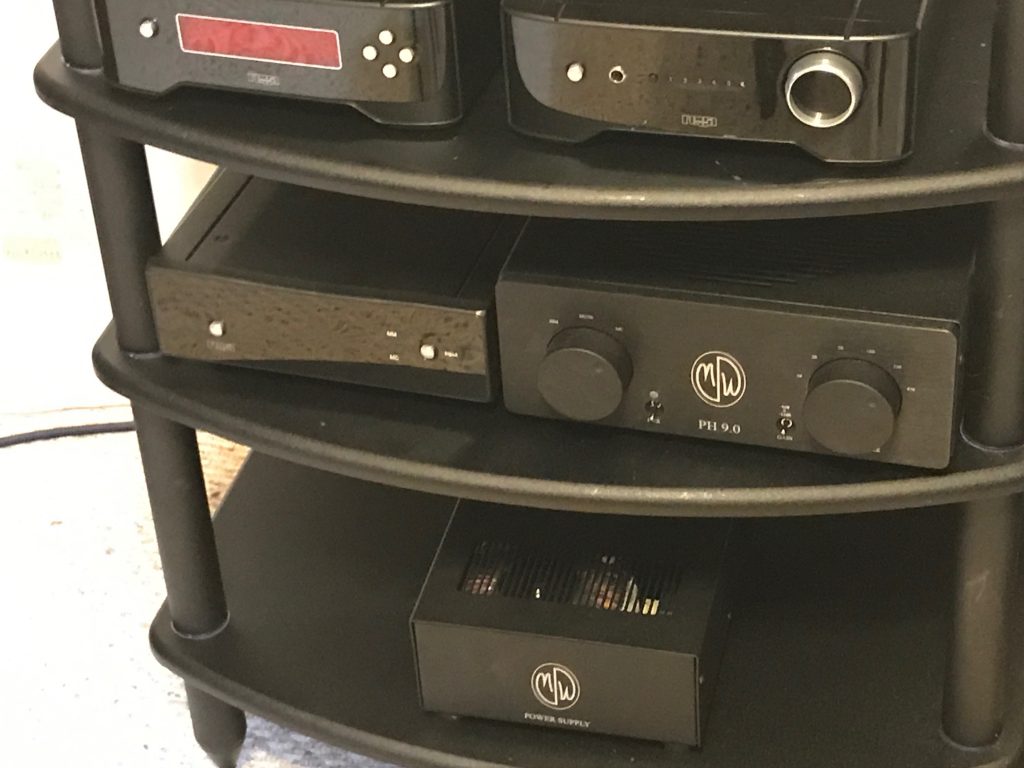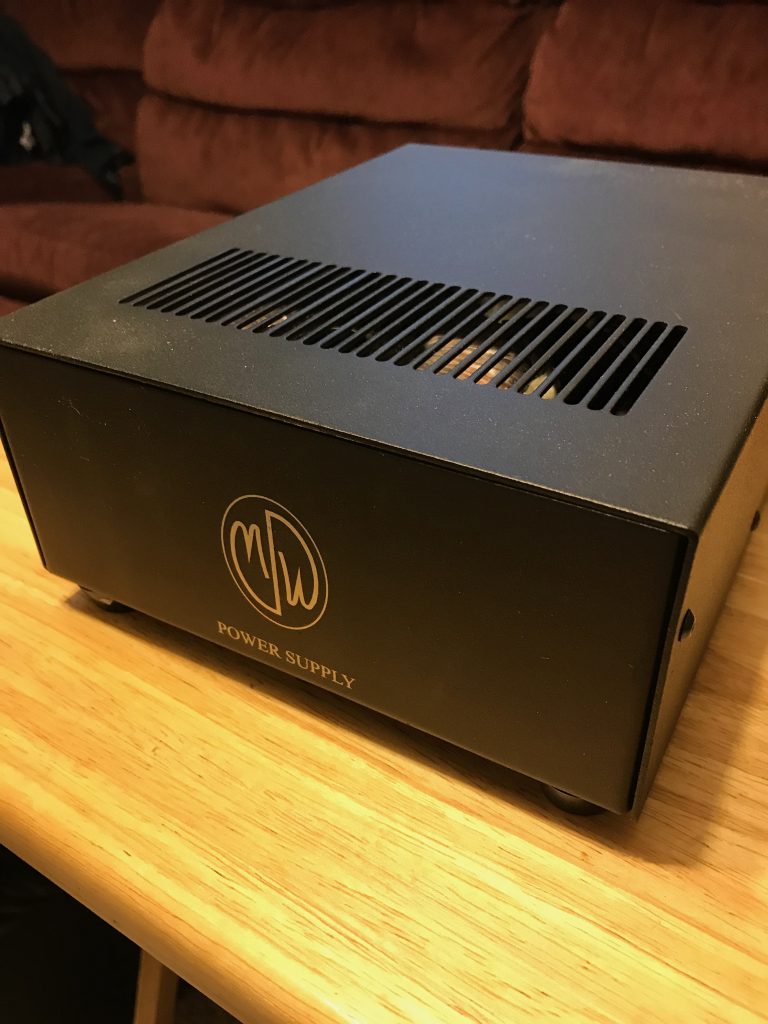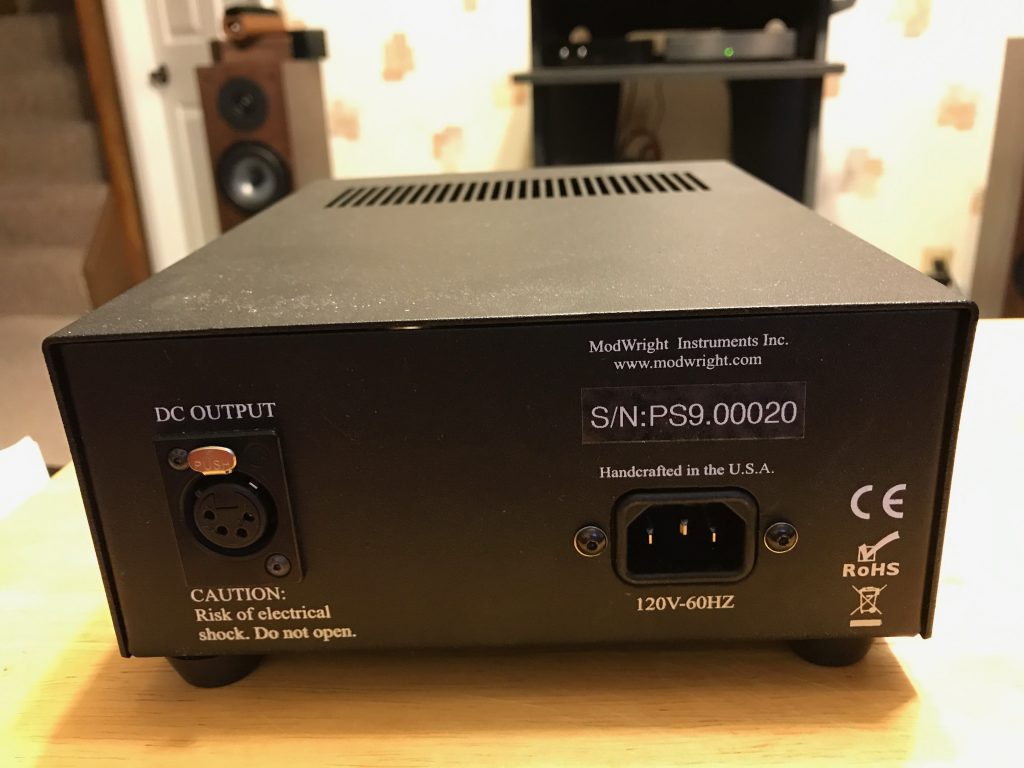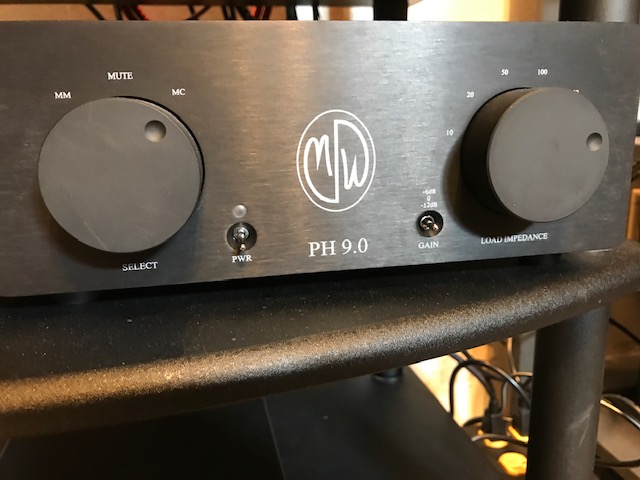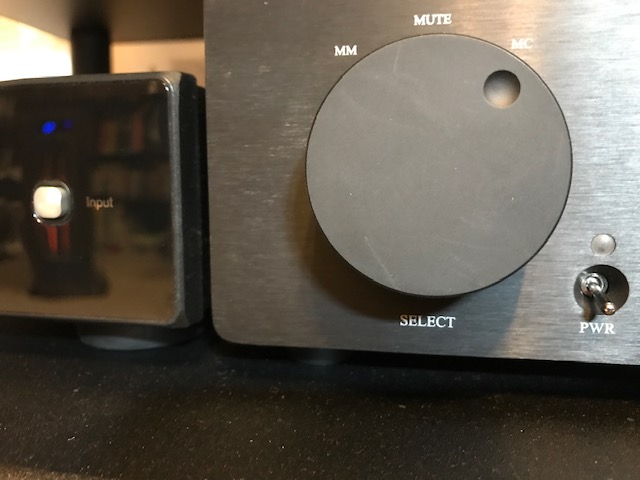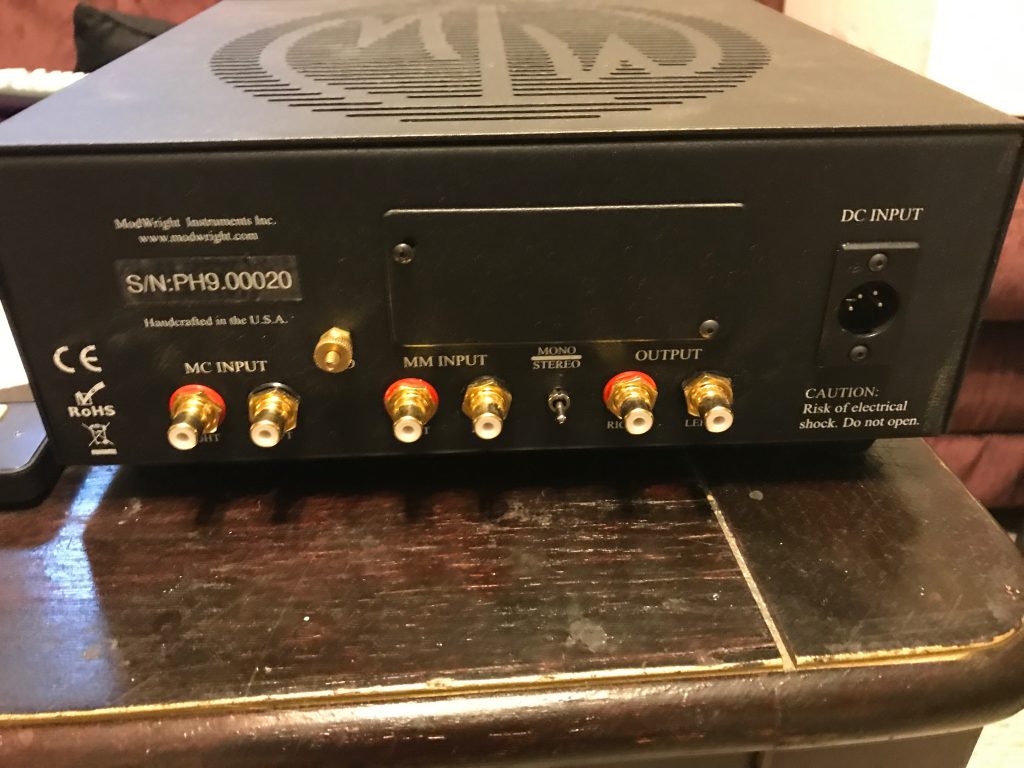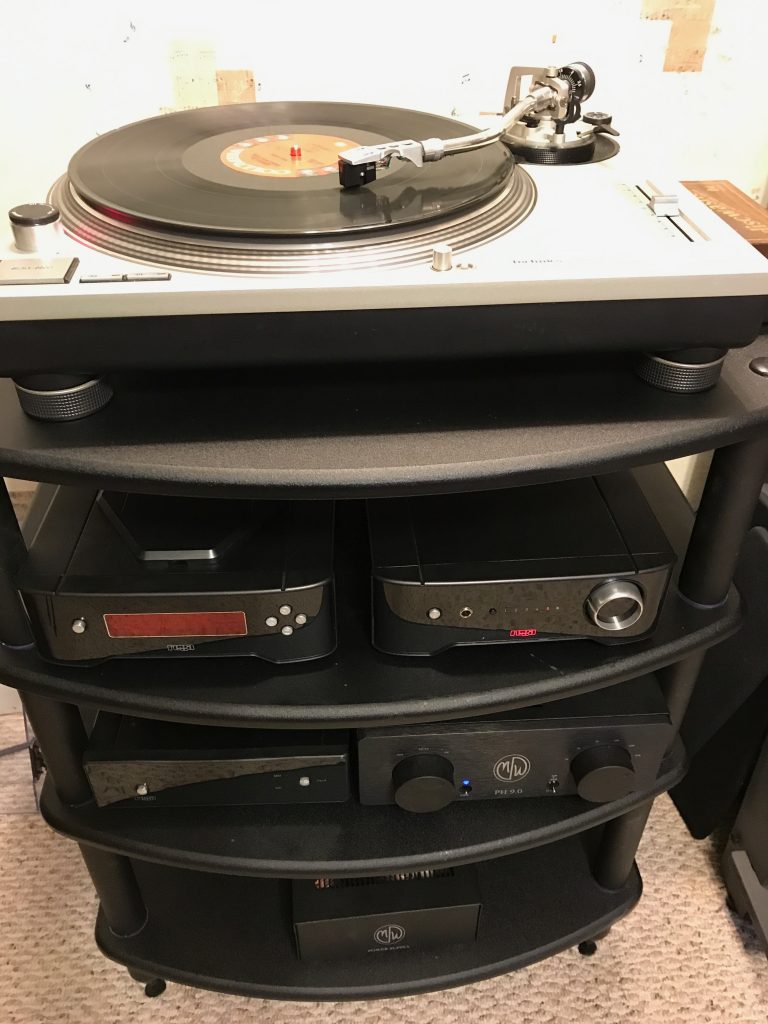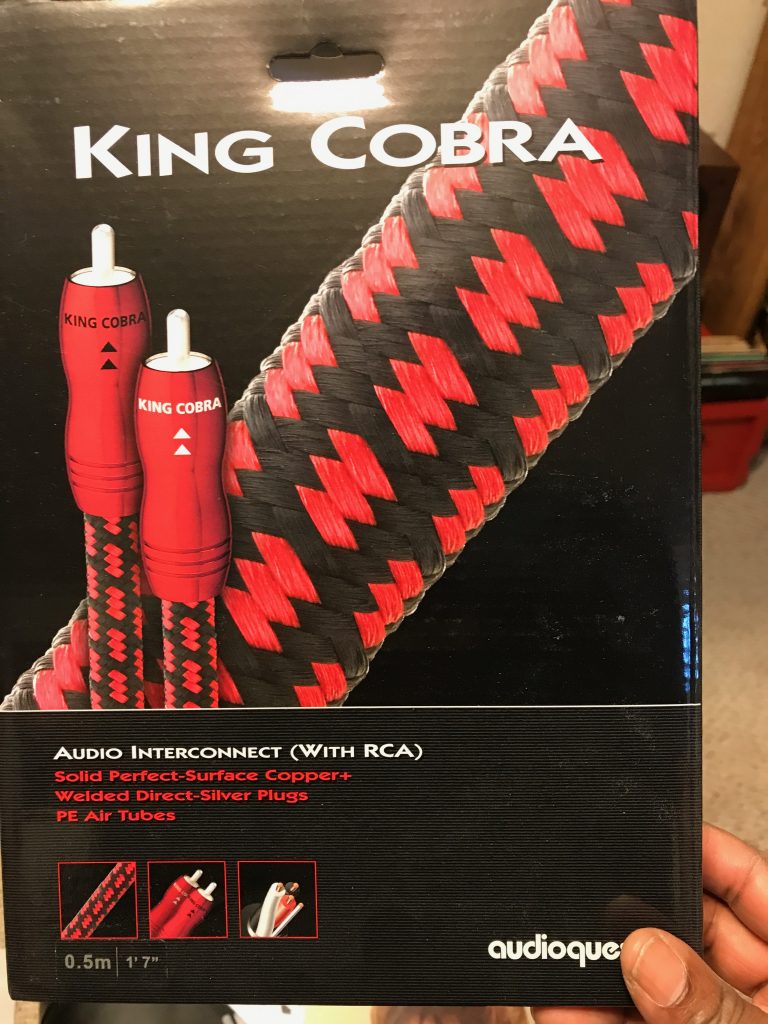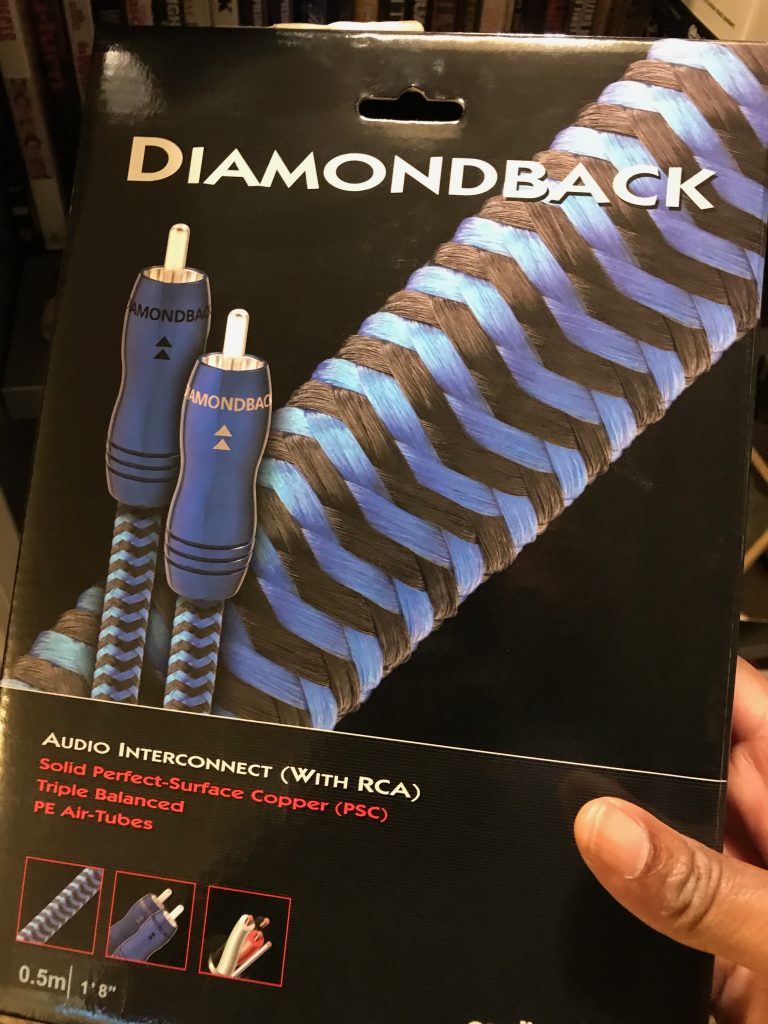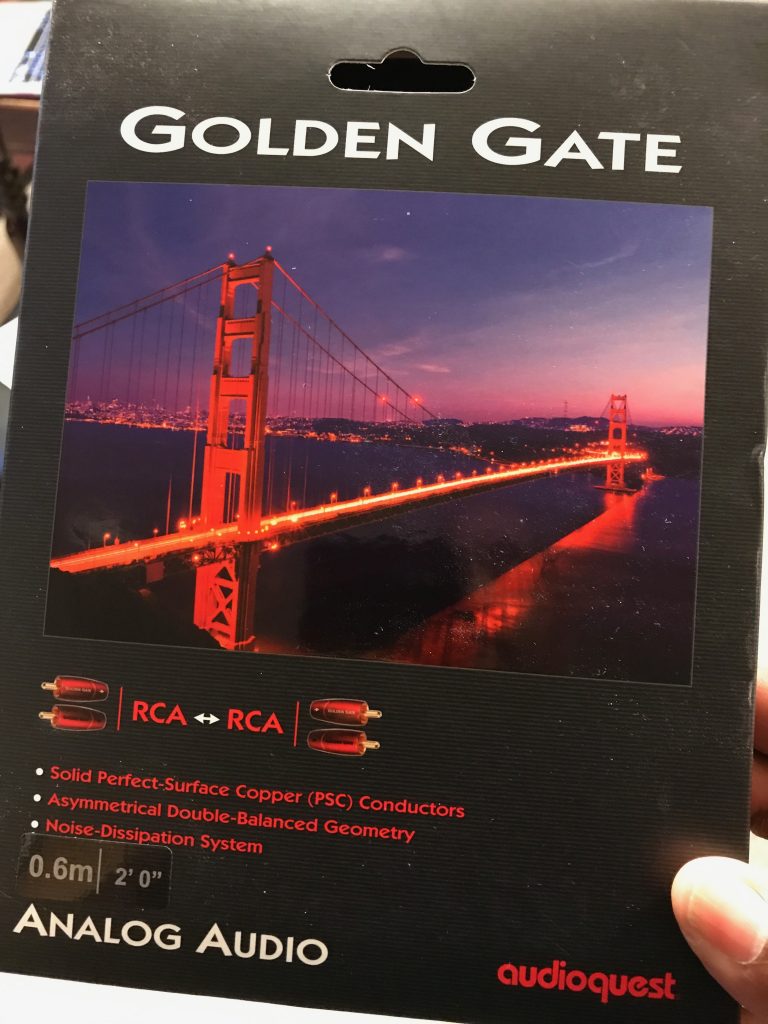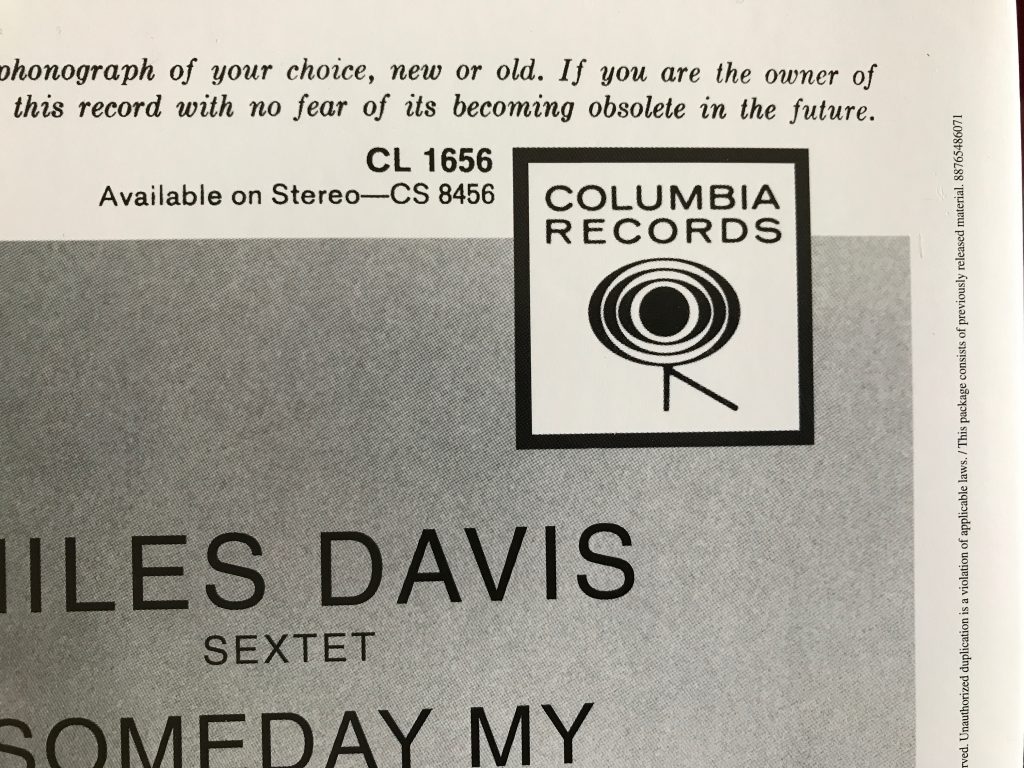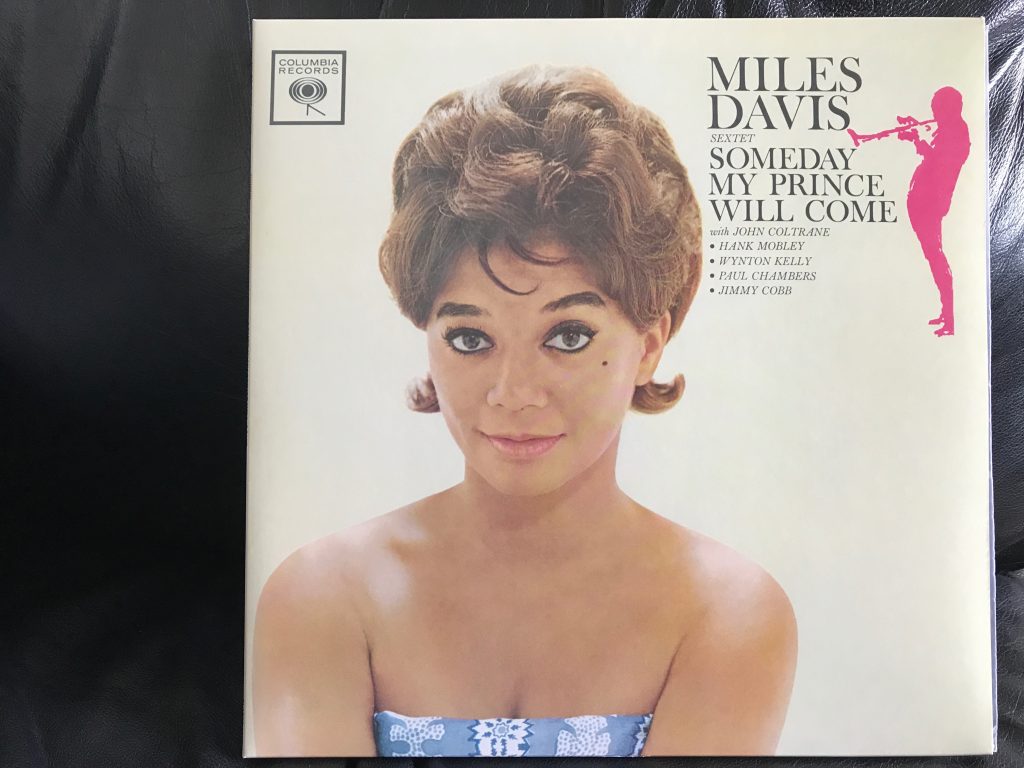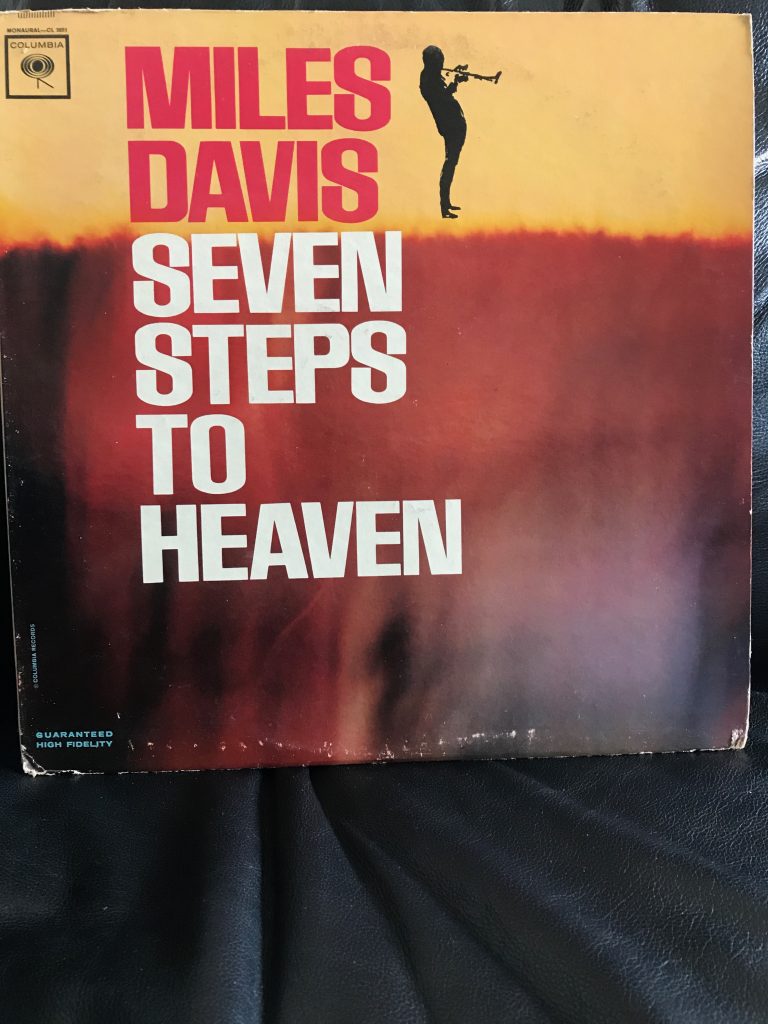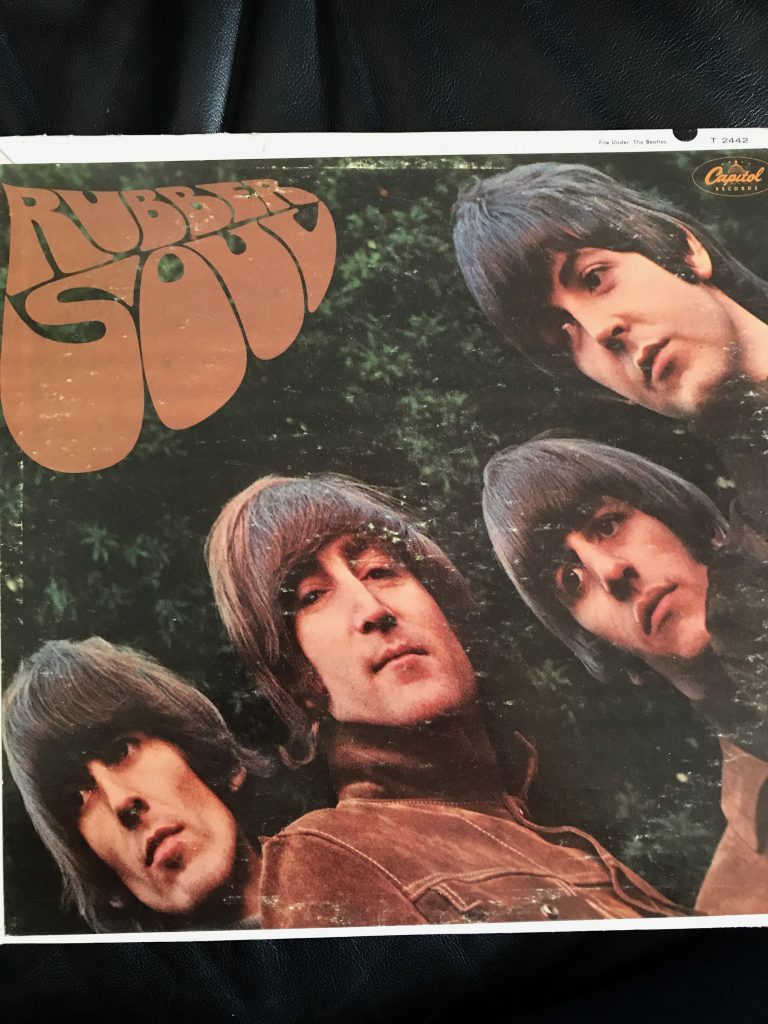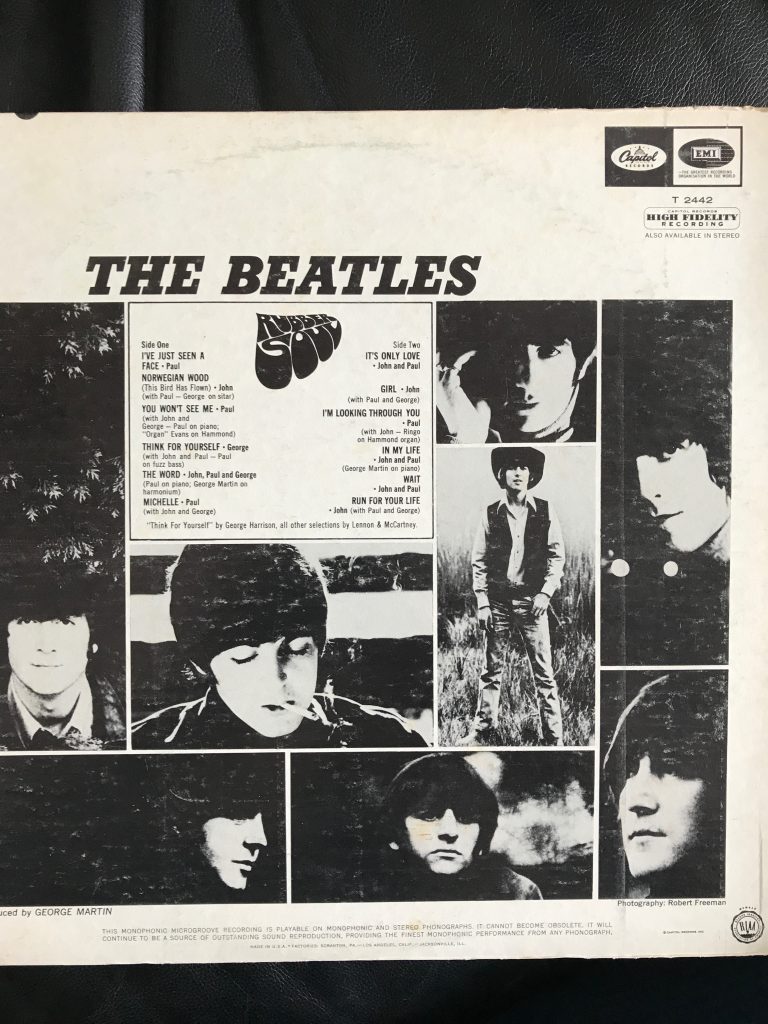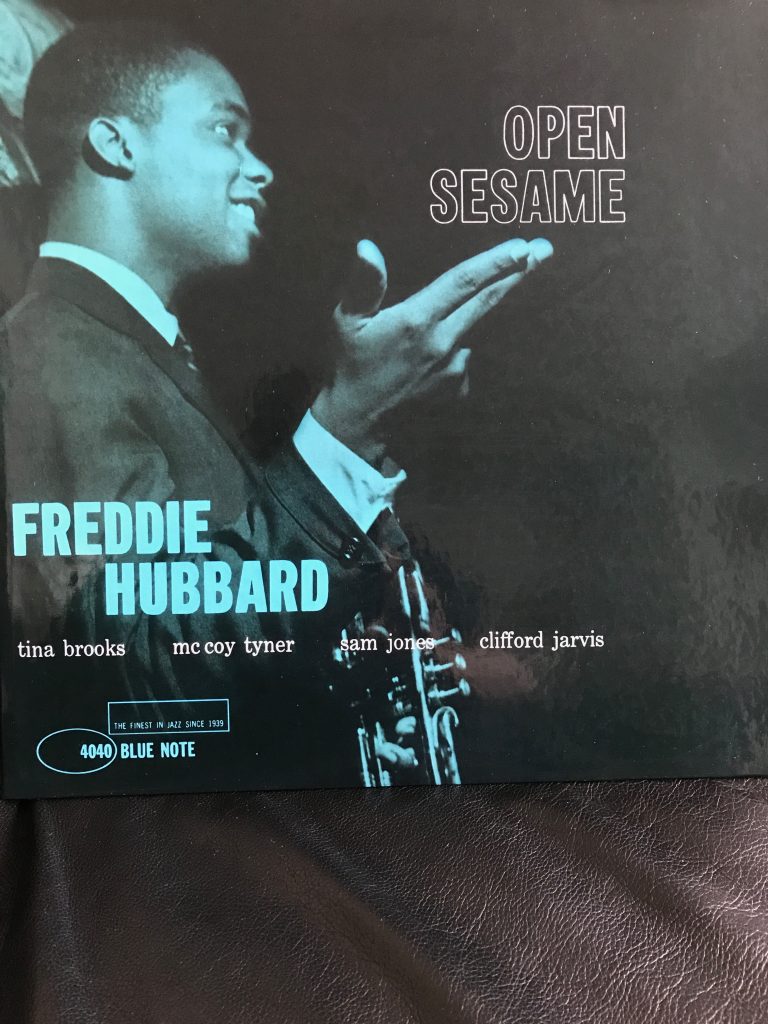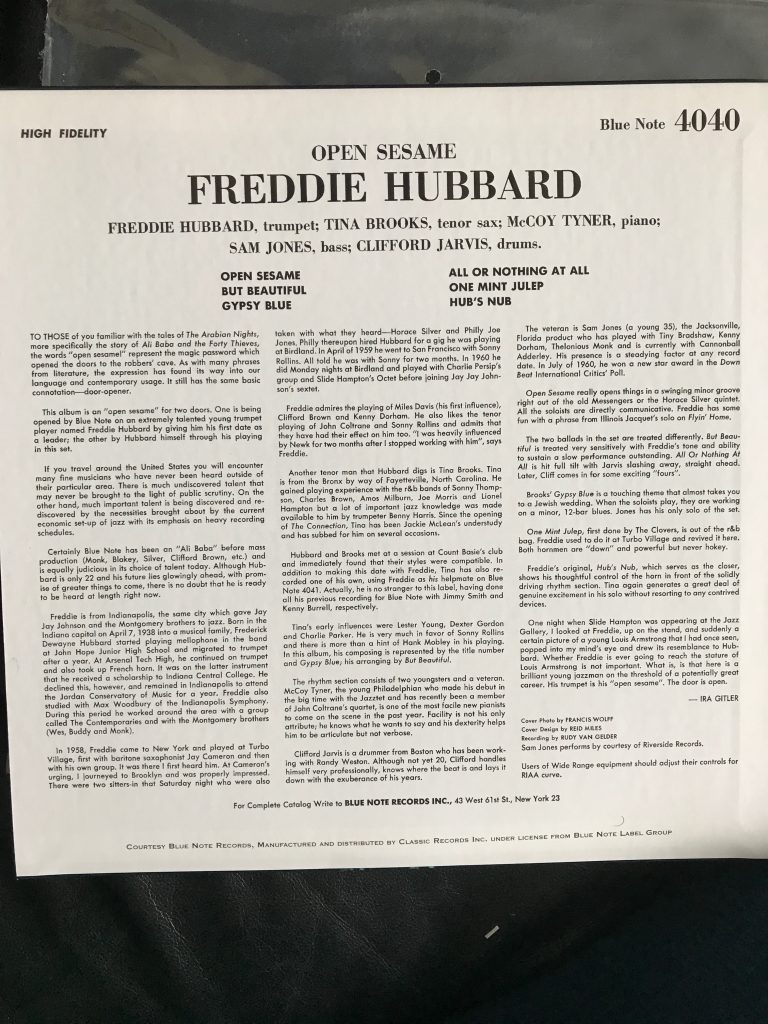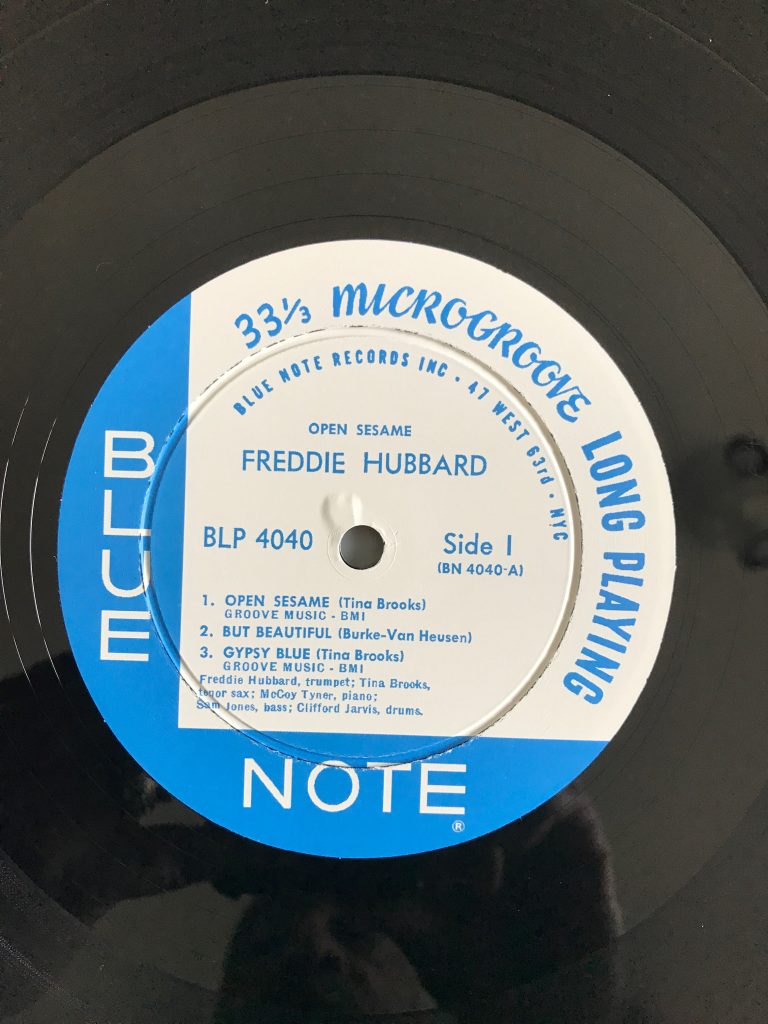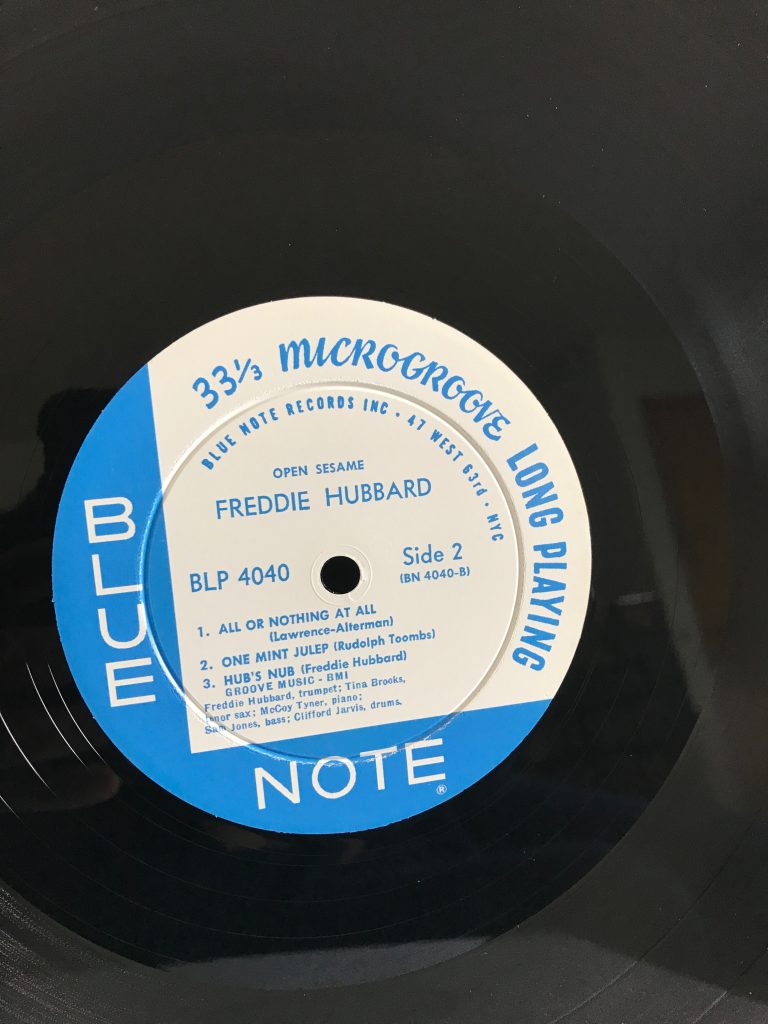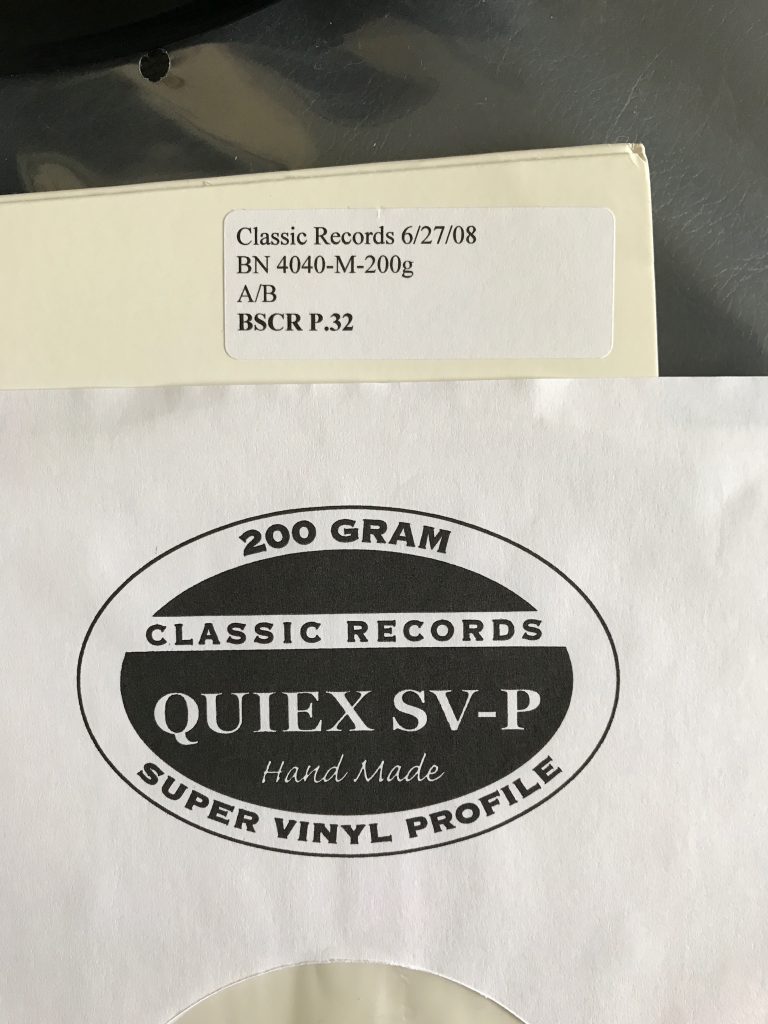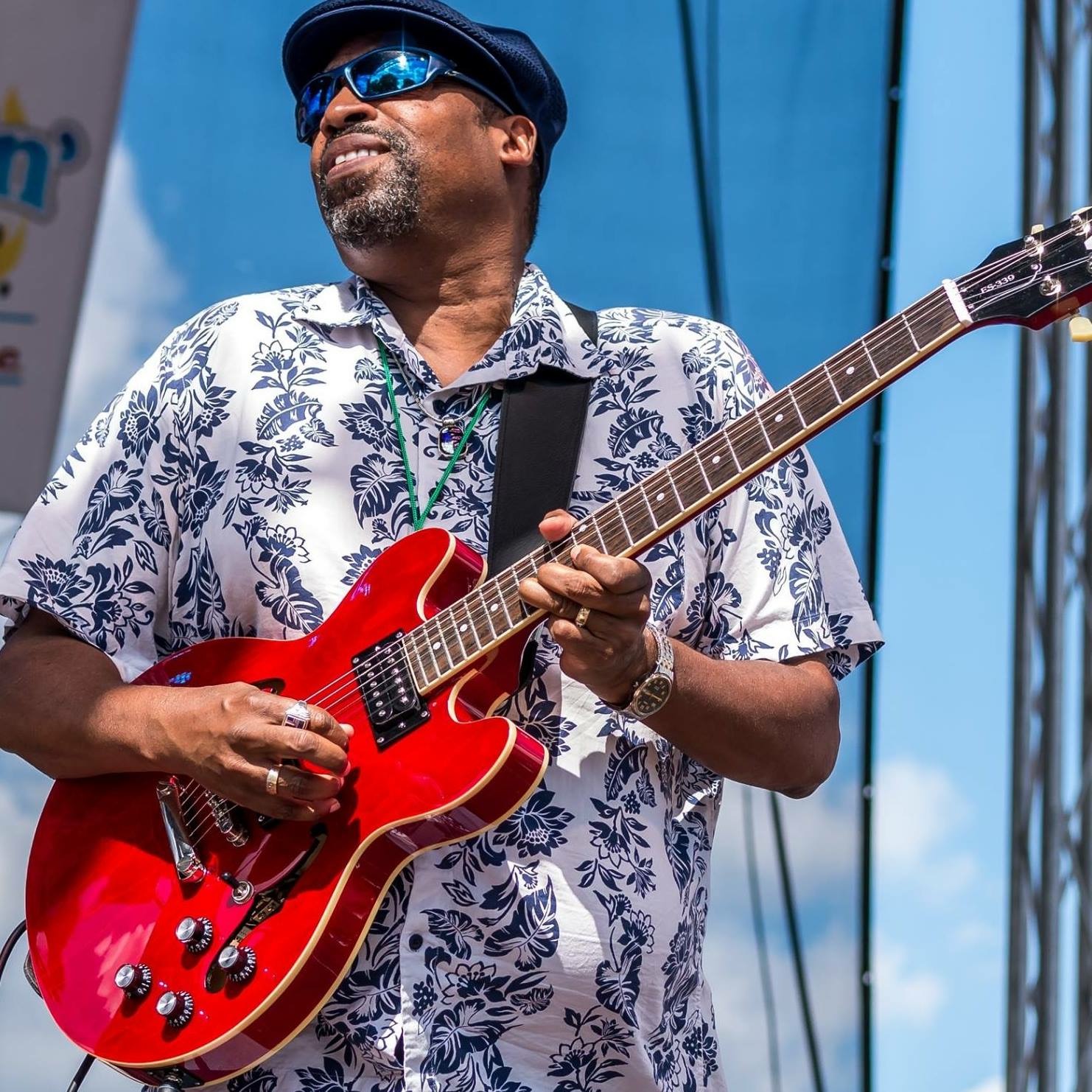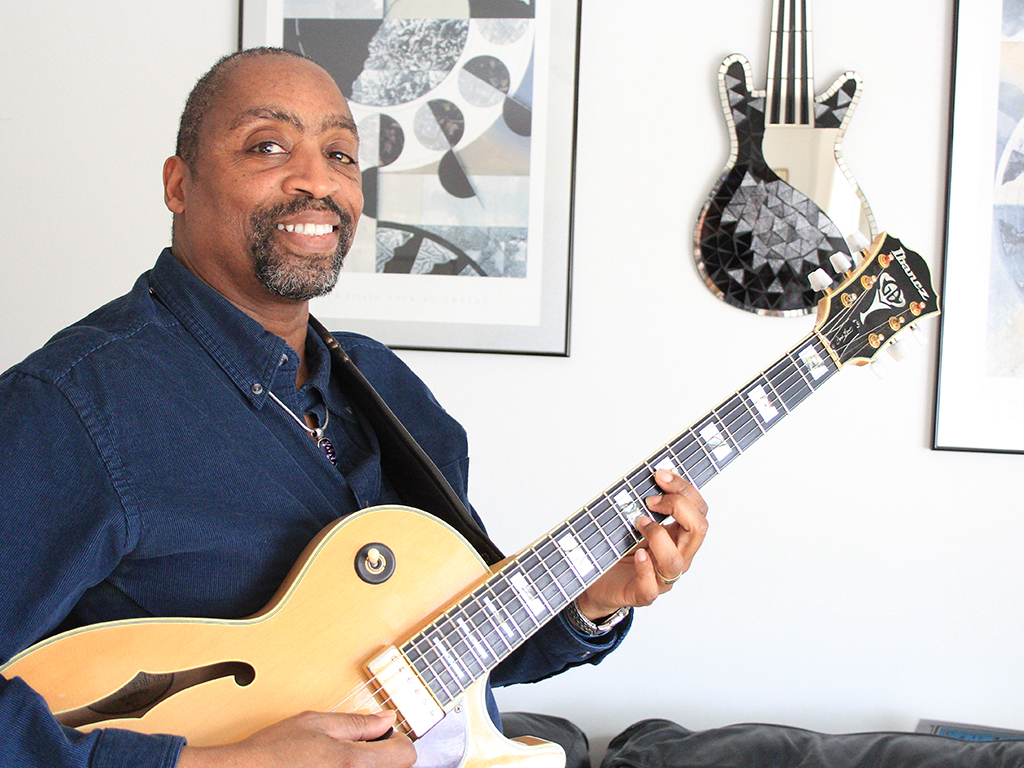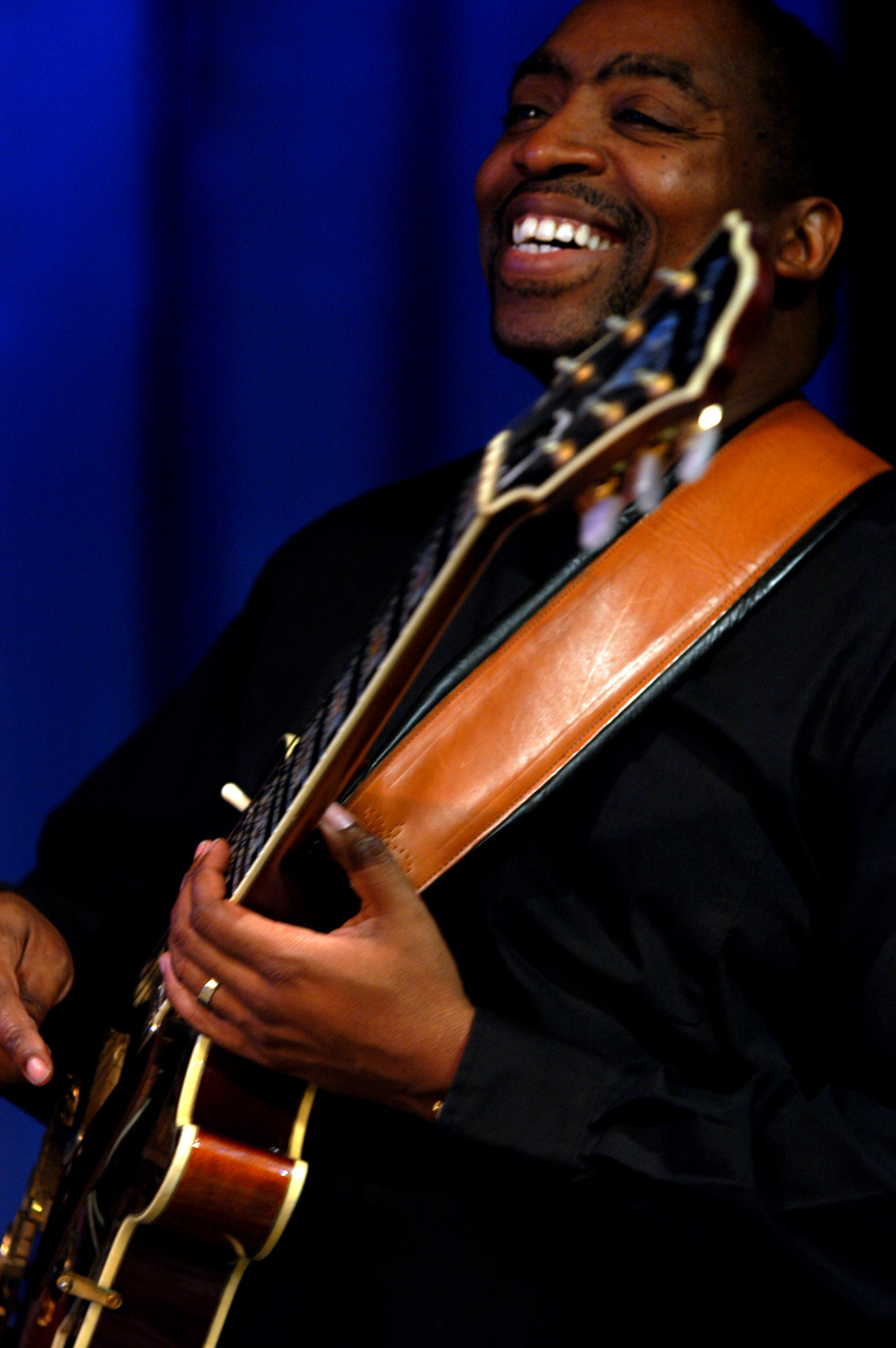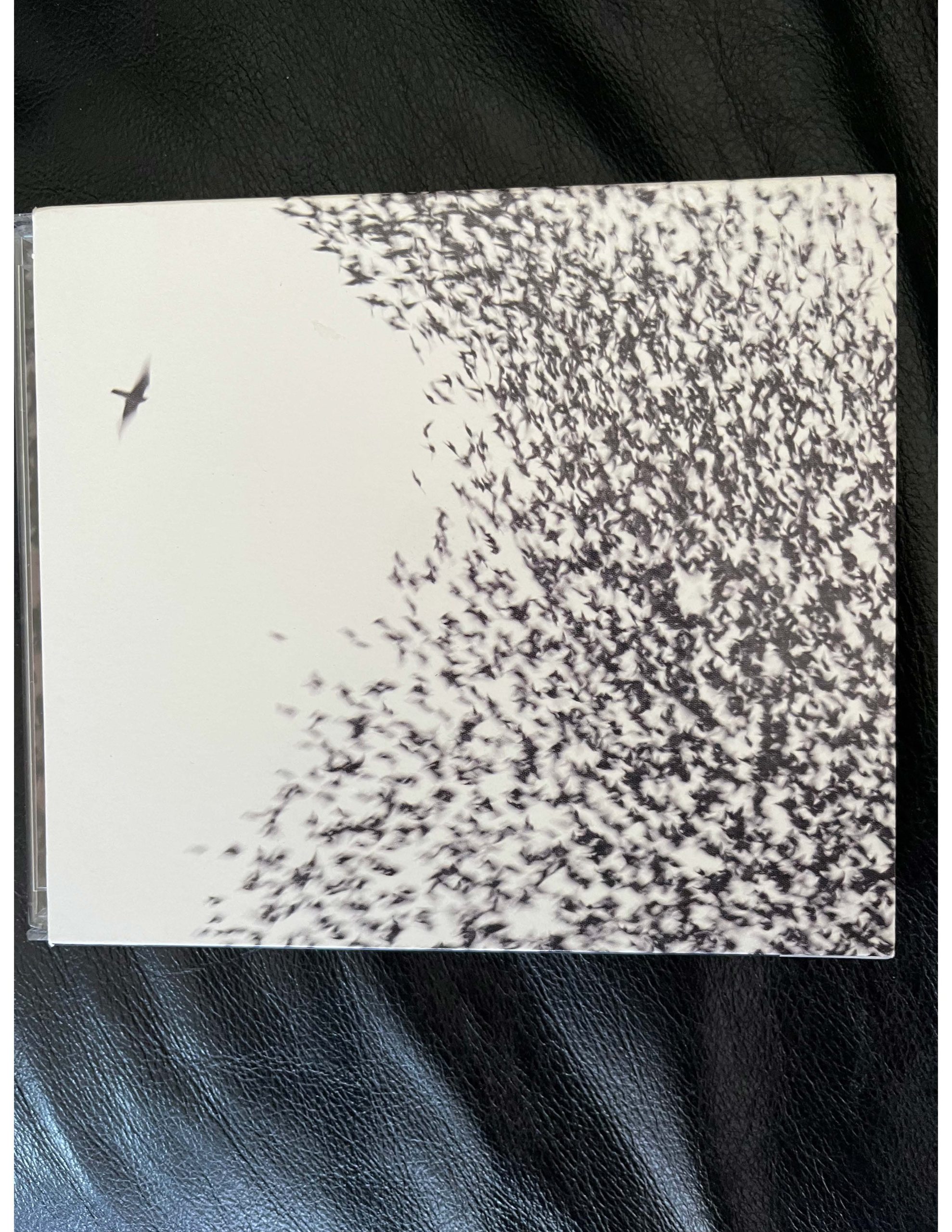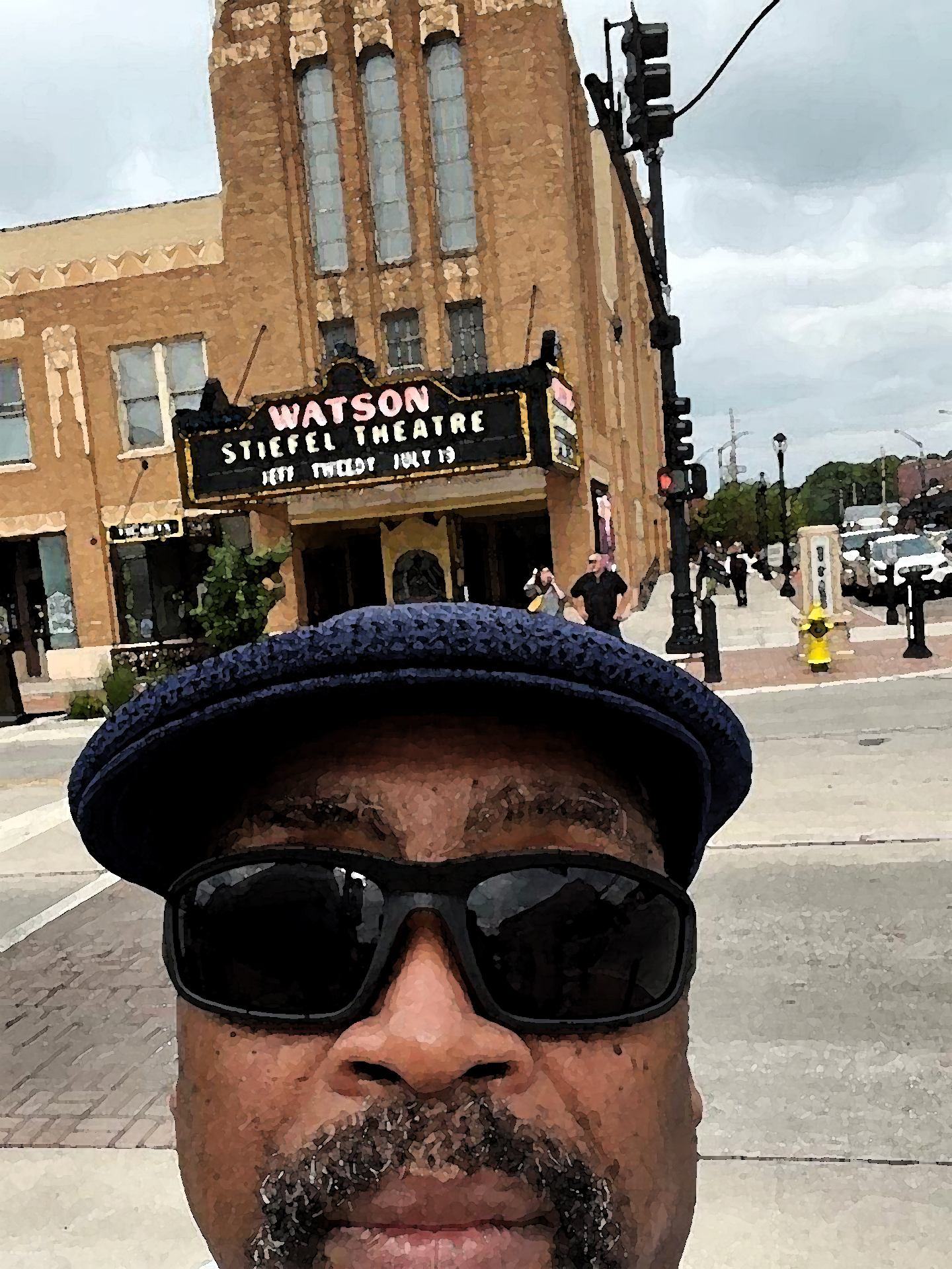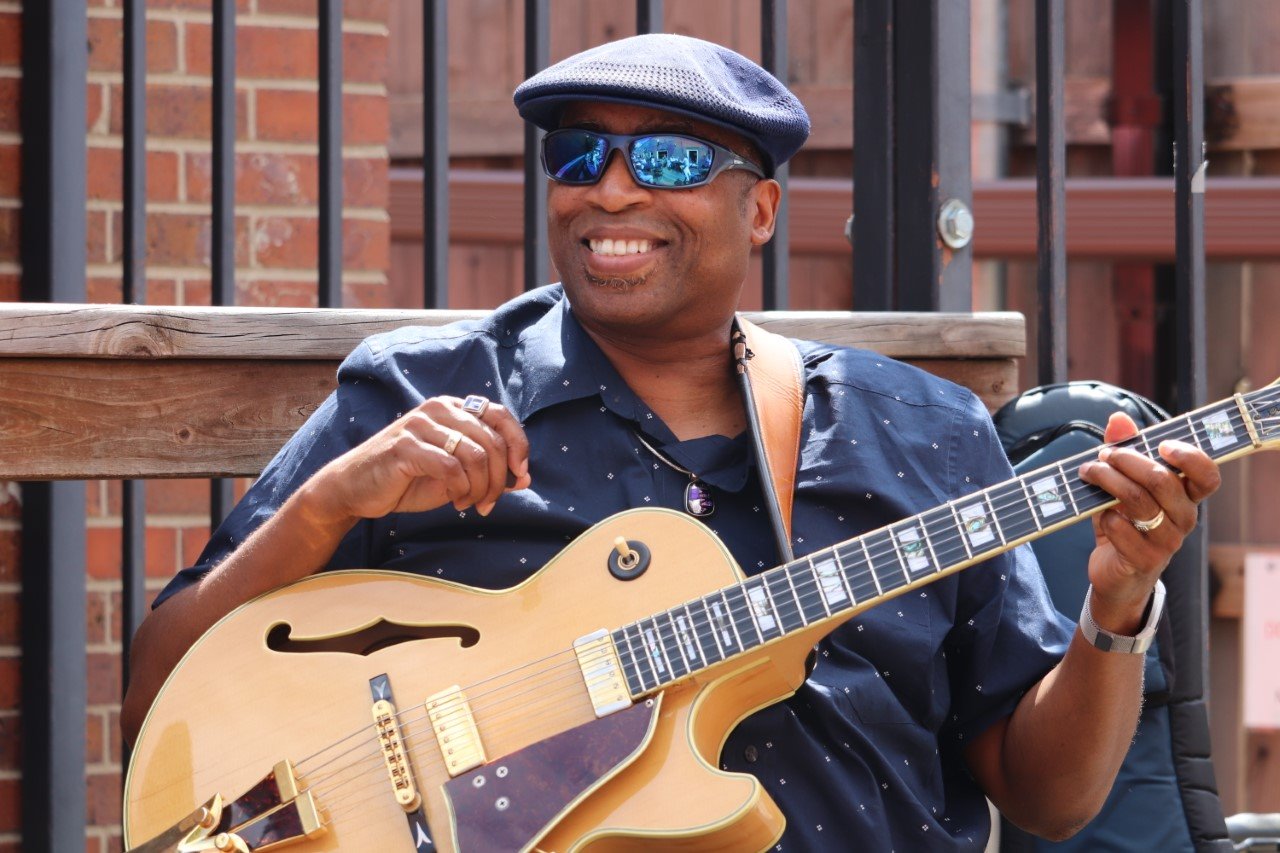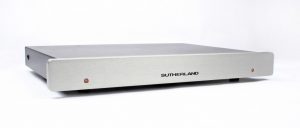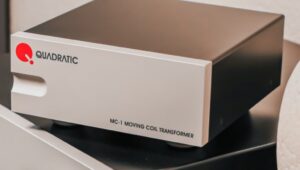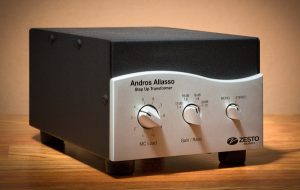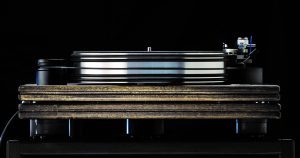Wayne Goins and Henri Musselwhite: a portrait. Salina, KS, 2017. Photograph by David W. Robinson.
A coupla months ago, I had a new experience when Dan Wright loaned me his ModWright PH 150 tube preamp for several months. Published in PF Issue 100 (HERE), I wrote about using the "mono" button on the front panel to achieve the desired effect. I really liked what I heard from the PH 150, except that a few other components it was combined with were not quite exactly what I needed to achieve the ultimate mono experience. But there was good reason for this—let's rewind just a bit for the sake of clarity.
In my article published in PF Issue 100 (HERE), I was doing a review of various pieces of stereo equipment using the setup of a VPI Prime Scout turntable (mounted with an Ortofon Black 2M moving magnet cartridge) powered by LTA Microzotl preamp and Ultralinear amp, WyWires Platinum Series interconnects, and a large pair of gorgeous Daedalus Athena V.2 floor speakers; all of which yielded—to no one's surprise—great results. After six months of immersion in aural ecstasy, I finally had to relinquish all the toys the benevolent audio gangsters loaned to me, and parting was such sweet sorrow—especially since I'd never borrowed so many pieces at once.
I was gonna need a lot of help packing everything up perfectly in the large and numerous boxes I wisely kept intact—peanuts, bubble wrap, paper stuffing's, Styrofoam casing and all. I called my own personal "A" Team—Nate Lennox from Acoustic Sounds and Chad Stelly from Musical Surroundings—who both arrived to the house and so generously lent their expertise to help me re-package and seal every item in excellent condition. First they disassembled the entire rig…
…then figured out how to strategically re-insert all the individual items in the exact manner with which they were sent to me.
They operated with surgical precision—I knew I could have never done it alone correctly.
Now that my recent exploits had finally come to an end, I was finally ready to start this new excursion—an itch that I've been wanting to scratch for some time now. In PF Issue 101 (HERE), when I shared with you how badly I wanted to experience what both Herb Reichert and Tom Gibbs had felt when they boasted about the Hana cartridges, I had my eyes on this very specific item: the low-output Mono SL. As for which preamp to best pair with it, I had several options: I could use the Rega Aria, which I had bought several months ago and hadn't yet used; or I could go with my original dream and use the Musical Surroundings Phenomena II+; or I could use the upgraded MS Nova III that Stelly had recently turned me on to, which sounded so awesome with the Rega rig.
I launched my newest formula for monosonic success by first blowing the dust off my rock-solid, vintage Technics SL-1200 MKII turntable, effectively bring it out of retirement and re-enlisted to serve on the front line.
I purchased this piece in 1994 after I bought my very first home when was living in the Doraville suburb of Atlanta, Georgia. So now I figured since I already had a dedicated stereo setup rig using my Rega Planar 6, the veteran Technics table would be used as an excellent choice to pair up with this Hana SL Mono cartridge ($750).
Both Nate and Stelly had unanimously agreed that it would be an ideal matchup. Actually, I'd already experienced the power of Hana when Stelly custom-fitted the Hana ML on my Rega Planar 6 during his last visit (the Microline is a superior low-output cartridge that made my entire Rega rig sing in harmony, so I had no reason to doubt the capability of the SL.). Here are the stats for the mono:
- Stylus: Nude Diamond Shibata
- Output Level: 0.5 mv / 1 kHz
- Output Balance: <1.5db/1KHz
- Vertical tracking force: 2g
- Trackability: 70µm/2g
- Frequency Response: 15-32,000Hz
- Impedance: 30Ω/1KHz
- Inductance: 40 µH
- Suggested Load Impedance: >400Ω
- Cartridge weight: 5g
- Cartridge Color: black
I quickly made arrangements through Nate to purchase the item from Acoustic Sounds upon his return to Salina, Kansas. I also asked him to mount it on a spare Audio-Technica head shell I co-opted from my AT-LP USB 120 turntable that wasn't currently being used (since I'd graduated and moved up to all this other stuff!).
Things were rapidly shaping up—but the best was yet to come.
Dan Wright knew that I'd already wrapped up my review of the PH 150 preamp, and, as luck would have it, my timing couldn't have been better because he was on the verge of unveiling his latest product—the ModWright PH 9.0 ($2900), the younger sibling of the PH 150. I'd read a coupla really nice reviews about it, and seeing as how I'd just recently returned the PH 150, Dan and I were both wondering: How would the PH 9.0 would compare in my estimation? I had to find out. I committed to doing an official review, Dan sent me the unit, and it was up and running within minutes upon its arrival.
So let's take a peek, shall we?
This spunky little unit comes in both black and silver (I preferred the black version, which would look right at home sitting next to the sleek Rega components on my Pangea rack.)
This phono stage weighs 12 lbs and is 10" wide, 10" deep, and 4" tall; the accompanying power supply is 17 lbs, 7" wide, 9" long, and 3" tall.
Inside the PH9.0 are four tubes—two 6922 signal tubes (which can also use 6DJ8 or 7308 as compatible substitutes), and two 6C45 signal tubes. On the front panel there is a 3-way toggle switch to use for selecting positions for your chosen gain attenuation. The middle position is default '0' gain of 64 dB for MC; you flip the switch up to back off to -6 dB (for 58 dB), and flip the switch down to back off more for -12db (52 dB). Likewise, the middle position is default '0' gain of 52 dB for MM; you flip the switch up to back off -6 dB (46 dB), and flip the switch down to back off more for -12 dB (40 dB).
The left dial on the front of the box is a 4-position knob that allows you to choose between MM and MC, with two 'mute' positions added in between for noise cancellation when switching positions from either MM or MC setting.
The other dial on the right of the logo is 6-position knob designated for resistance loading, and offers MC settings of either 10, 20, 50, 110, 150, or 470 (this is absolutely ideal for people like me who don't wanna lift the hood to adjust individual dip switches.)
The MM default setting is typically fixed at 47k.
In the rear of the box there is a pair of right/left RCA inputs for MC, and a separate pair of right/left RCA inputs for MM. Of course, the perk that comes along with having a phono stage with two inputs means that if you had two arms on a table or two separate turntables, you could run both mono MC and a stereo MM or MC cart (if you used a low output MC, you would just need to add an outboard step up transformer.)
There are two RCA outputs for left/right, and a pair of balanced XLR outputs as well. There's a two-way toggle switch on the back plate which allows you to flip to either a stereo or mono setting, and the required DC input socket.
As you might expect, the manufacturer suggests that you keep the power supply well separated from the phono stage to achieve the lowest noise possible.
So, my complete "Mono Rig" setup is as follows: Technics SL1200 MKII turntable with Hana SL mono MC cartridge, coming through the ModWright PH 9.0 tube phono stage (with power supply), which is driven by the Rega Brio integrated amplifier (coming through input 5) and delivered through my Spendor D5 floor speakers.
I used Audioquest (King Cobra Red, Diamondback Blue, and Golden Gate Red) audio interconnects.
Since the Hana SL recommends to set the load impedance: >400Ω, the knob setting is turned all the way to the right at 470. Alright, now it's time to get to the music—some oldies and some newbies. Let's open 'er up and hear what's under the hood of this PH 9.0!
First up is the Sony Legacy re-issue of the Miles Davis classic, Someday My Prince Will Come (CL 1656)—a mono version originally released on April 20, 2013 as a numbered, 180-gram vinyl pressing (officially released to Record Store Day fans on June 4.)
In my first "true" mono experience, I perceived that the instruments emerging from the speakers reveal themselves sonically as more "front-to-back" instead of "side-to-side," with thorough midrange heard in the piano, sparkling clarity in the upper-register from Miles's clarion trumpet, and firm-yet-subtle bass tones from Paul Chambers. It's a beautiful balance. Throughout the entirety of the title track, smooth transients emerge when the right hand of Wynton Kelly's piano creates chiming chords and arpeggios on "Old Folks," or when Miles uses his mute to wail in agony on his solo during that tune. The overall result is a sensation that feels like something other than my stereo listening experience—it's a bit more like the sound one gets at a live concert, or a what studio monitors would yield in the engineer's playback booth.
For me, the greatest revelation was the unbelievably low noise floor—Stelly says this is the first sign of a great mono cartridge, and this is where I first come to appreciate the ability of a great stylus to effectively transmit the horizontal dimensions of a good mono record without the vertical obstructions. This aspect allowed for the stunning clarity of Jimmy Cobb's brushes, hi-hat and cymbal work—which is exactly what I listen for first when I'm sizing up drummers. On the other end of the sonic spectrum, the bass resonance in these Spendors are sublime, offering just the right amount. As the first muted trumpet notes of "Drad Dog" come bursting through, Miles's tones become more articulate as he moves glacially toward the upper register in his brief but effective opening melodic statement. It doesn't take long for me to realize that this Technics/Hana/ModWright combination is working in seemingly effortless fashion.
The cross-stick and polyrhythmic technique from drummer Jimmy Cobb is crystal clear on "Teo," as well as on the traditional blues form, "Pfrancing,' while the razor-like tones of Miles cut straight through the high end as he pierces the ceiling. Meanwhile, Chambers' sustained bass ostinato pattern is rolling, and the tenor sax solo on Coltrane shimmers when he lunges upward from the root to the fifth and hits the concert C pitch as the quintet vamps in F minor during the ¾-metered feast. Finally, on "I Thought About You," I can actually hear Miles breathing through the muted bell; you can hear him literally pushing the air through the horn.
I was so elated with the response of the ModWright's full embrace of the Hana SL Mono cartridge that I decided to dig deeper into the Miles mode. I got an original U.S. copy of Miles Davis Seven Steps to Heaven released on Columbia in September 1963 (CL 2081).
Those classic late '50s and early 60s discs on Columbia just sound fantastic. But this mono experience is making me re-think (re-hear) everything I thought I heard on certain albums I fell in love with. Maybe it's just me falling in love with the killer ModWright/Hana/Technics combo, but listening to "Basin Street Blues," "I Fall In Love Too Easily," "So Near, So Far," "Baby Won't You Please Come Home," and "Joshua" makes me appreciate this album all over again.
I'm having such a great time with this listening session that for once in my life I'm feeling like the very idea of stereo was invented at the expense of mono's reputation! In fact, the more I think about it, I do recall somewhere way back in my younger days thinking that mono was a bad thing—an old thing, maybe even a dirty-sounding thing. Boy, I couldn't have been more "wronger" about that. ("I'm so sorry, mono. I apologize. I love you!")
I got an original mono version of the Beatles 1965 Rubber Soul on Capitol Records (T 2442) from my friend Drew Palmer who found it at a garage sale, and it was in excellent condition!
Played through the PH 9.0, I was impressed with how low the noise floor was. The guitars and George's sitar of "Norwegian Wood" rang as clear as a bell, as did the "oooh la-la-las" underneath Paul's lead vocal on "You Won't See Me." "Michelle" sounded wonderful. Paul's vocals were round and lean, the Ringo's percussive presence on "In My Life" was crystalline, and Lennon's voice on "Girl" is warm, with George and Paul providing tight harmonies behind him. I must say, it made me wanna buy the entire mono box set. And then I looked at the going rate, and decided not to—maybe I will settle for just Rubber Soul—it's probably my favorite of all their albums. In the meantime, this free, original, near-mint mono pressing of Rubber Soul just sounds better and better with every spin. This Technics/Hana/ModWright combo is kickin' some serious ass in my basement, y'all—not even kidding.
My idea for purchasing this next album up for review was stimulated by a thorough and highly-passionate article by a legendary jazz pianist Benny Green. Benny is a personal friend and musical colleague in the jazz profession who was fortunate enough to be under the tutelage of members of the legendary Art Blakey & The Jazz Messengers. Green went on to become the pianist for Miles Davis bassist Ron Carter, and Benny later joined Freddie Hubbard's band, where he learned amazing stories from Hubbard and the time spent with Blakey. Benny also raved about Freddie's first recording for Blue Note that launched the trumpeter's career. But this first album shows he was already mature and ripe for the occasion. I bought this record because of Benny Green's unbridled enthusiasm and raw passion for the music and the man—Freddie Hubbard.
On June 19, 1960, Freddie recorded six tracks on Open Sesame for the Blue Note label (BLP 4040), and this mono version I have is the Classic Records re-mastered, Quiex SV-P 200g mono reissue (BN 4040-MONO-200G) released on September 19, 2008 (my birthday!)
The Classic Blue Note Signature Series reissues were cut from the original master tapes on an all-tube mono cutting system by Bernie Grundman.
The disc features Freddie, Tina Brooks on alto sax, Sam Jones on bass, Clifford Davis on drums (who sounds like a direct descendant of Art Blakey), and McCoy Tyner on piano. The legendary Blue Note 50s recordings have all become classics, as the company earned the reputation for being the standard-bearers of excellence during that era. They had a sure-fire winning recipe: Rudy Van Gelder recorded; label owner Alfred Lion produced; Ira Gitler (who just recently passed away) wrote liner notes for the back cover and Francis Wolff did the album front cover photography. Hell, they themselves were like a jazz quartet!
Actually Nate Lennox has a story related this epic Blue Note LP: "Back in the day, Classic Records owned the rights to do all of Blue Note's re-release catalog titles…so When Chad Kassem of Analogue Productions bought the entire catalog of Classic Records in 2008, he acquired everything—all the equipment, back stock, everything."
I bought it from Acoustic Sounds through Nate—it's a pristine pressing, the production is exquisite, and the performance is stellar. The mic placement on the drums is patented, the hi-hat cuts through, the tenor sax of Tina Brooks sounds Coltrane-like, but not as jarring, and McCoy Tyner's piano had the classic Van Gelder sound–totally without blemish, sonically speaking. No fault can be found in it, and the performance of each individual is simply unparalleled (unless it's another Van Gelder-engineered session for Blue Note), which makes it pretty much a perfect album for anyone's turntable.
Played on my Technics-led mono rig, every instrument on the opening track comes across rich and robust. The samba/uptempo swing groove of "Open Sesame" boasts the crystal clear trumpet tone of Freddie, which is quite different than that of Miles. It's fatter and rounder, almost exactly like when Miles plays flugelhorn on the Gil Evans-led Miles Ahead in 1957 on Columbia (CL 1041)
The ballad "But Beautiful" features Tina Brooks (I have no idea why his career was basically all but forgotten!) and a great languid solo from pianist McCoy Tyner (who hadn't yet joined Coltrane and was still a newcomer like Freddie was.) "Gypsy Blue" is a medium-tempo bossa nova with a harmonized melody; the groove switches to a straight swing as the drums and bass emerge, and has that patented beefy bottom that Blue Note records are all known for—every album under their banner has remarkable consistency, but the clarity of this disc puts you right there in the room. Freddie quotes his most lyrical solo on the entire album, and the tempo, groove and chord changes are totally reminiscent of "Stolen Moments" from the Oliver Nelson's 1961 Blues & The Abstract Truth album, which Freddie also played on.
On the smokin' hot tempo of "All Or Nothing At All," you can hear the reverb dialed in the mix. Freddie's robust tone literally reverberates above the smooth chatter of the hi-hat, snappy snare, and delicate ride pattern on the cymbal from Clifford Jarvis. The tune also features a robust acoustic piano solo from McCoy. Although "Hub's Nub" is the most sophisticated tune on the track and the only Freddie original tune—and swings like mad—the best sounding track on the entire album is "One Mint Julep," and this tune is officially the new reference recording for my mono listening experience. It might be because I pushed the volume up to somewhere between 10/11 o'clock, and this rig responded like you wouldn't believe—not one drop of distortion, just beef and balls. On Freddie's solo, the bass line of Sam Jones simply has to be heard—my words can't do it justice. It sounds so much like the groove on "Freddie the Freeloader" from Miles Davis's Kind of Blue. Which is making me wonder: is this why Miles named it that way? Is it just a coincidence that in the same tempo, and even the same key?—hmm… .
What's the Verdict?
My ultimate summary of the PH 9.0 is that it is a great piece. When one considers the purchase price, performance, and flexibility, it hits a home run for anyone who invests time and money in it. In fact, I did just that, and I'm here to announce that this unit will be the primary reference for my ongoing mono reviews as they evolve over the many articles to come. Dan is not only an awesome audio inventor, but more impressive, he is super-nice as a person and has a "user-friendly" approach to interacting with customers! He operates very much like how I basically view this PH 9.0—it's also user-friendly! It's absolutely excellent for people like me who are learning the ins-and-outs of the audio world. Things that many readers here already have a firm grasp on, like, for example, understanding the function and relationship between resistance and gain on phono stages. I really appreciate him for that.
I was so inspired by the sound of this preamp, I recently purchased quite a few new mono vinyl discs to share with you in upcoming issues, including the Ray Charles Atlantic Records mono box set, which has all the classics from the first seven LPs when he joined up with legendary record mogul Ahmet Urtegun in June, 1952!
So please tune for Part II of this article, where I will review Ray's box set and lots more mono-mania!
Until then, keep on' swingin!
ModWright
Hana, Musical Surroundings





